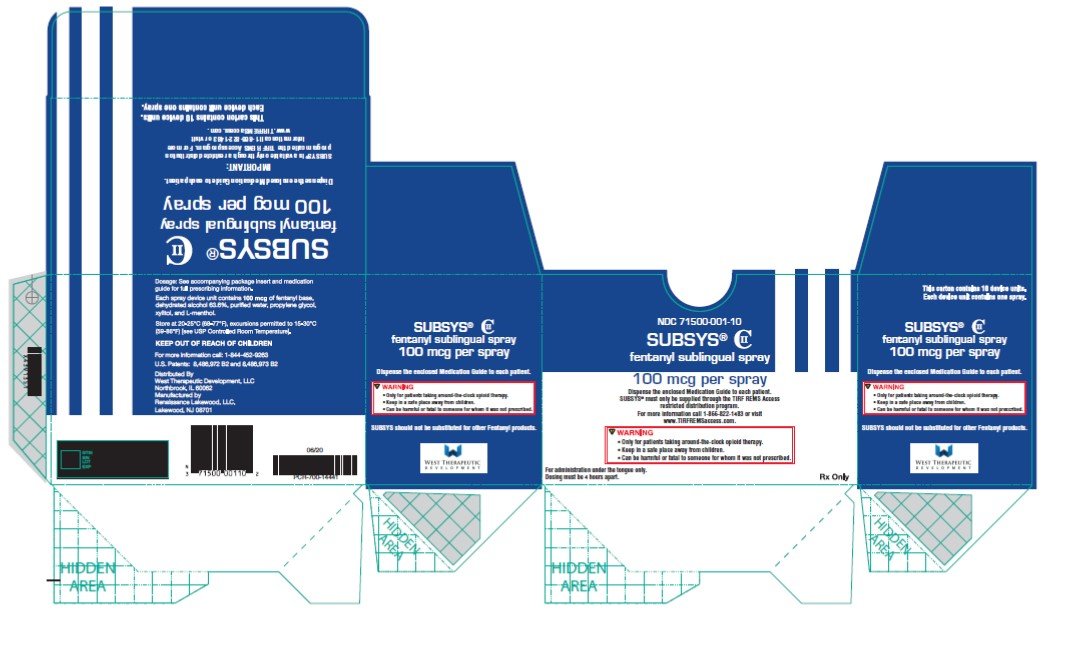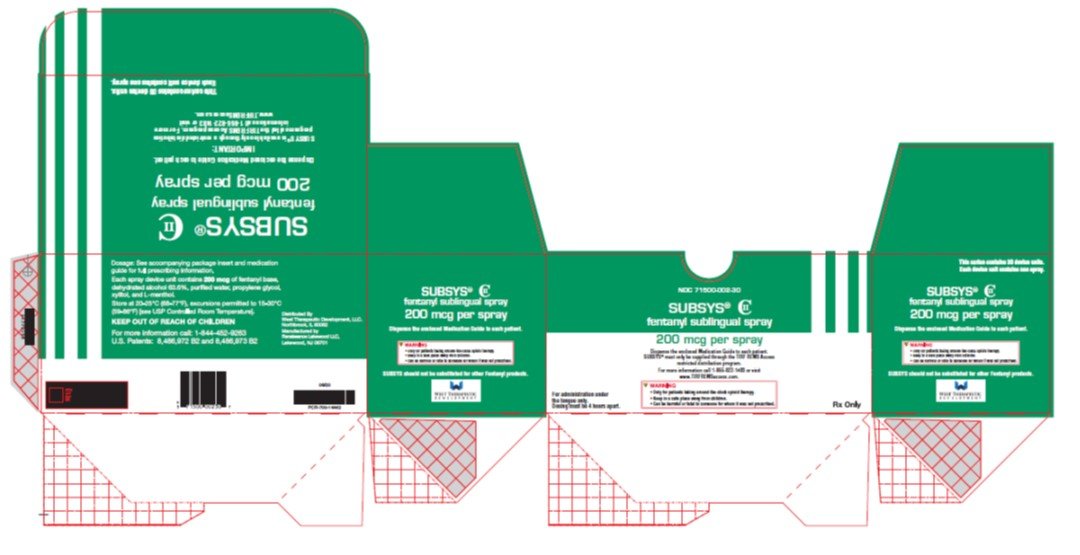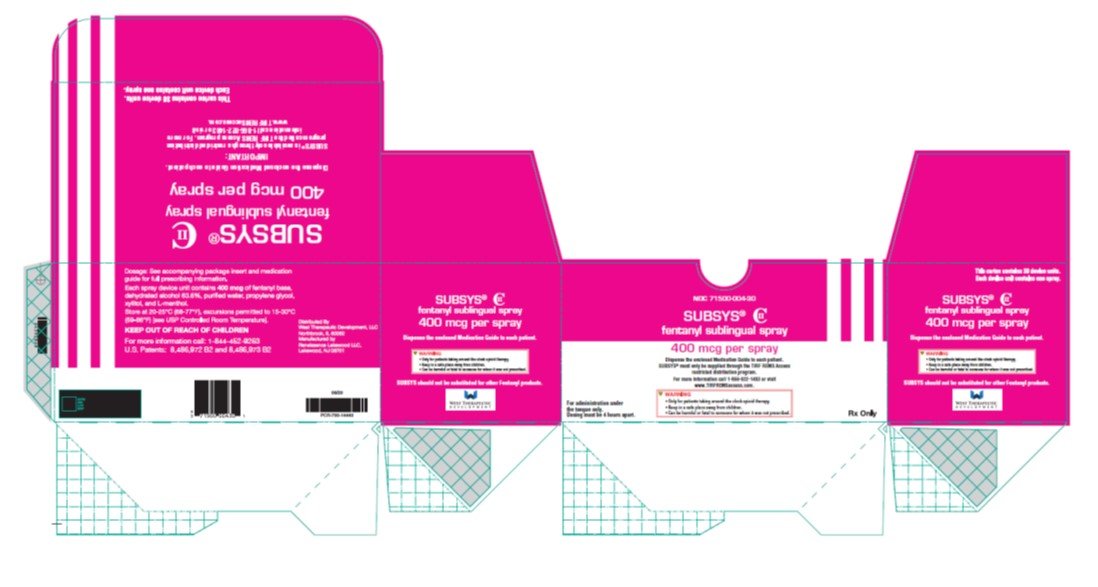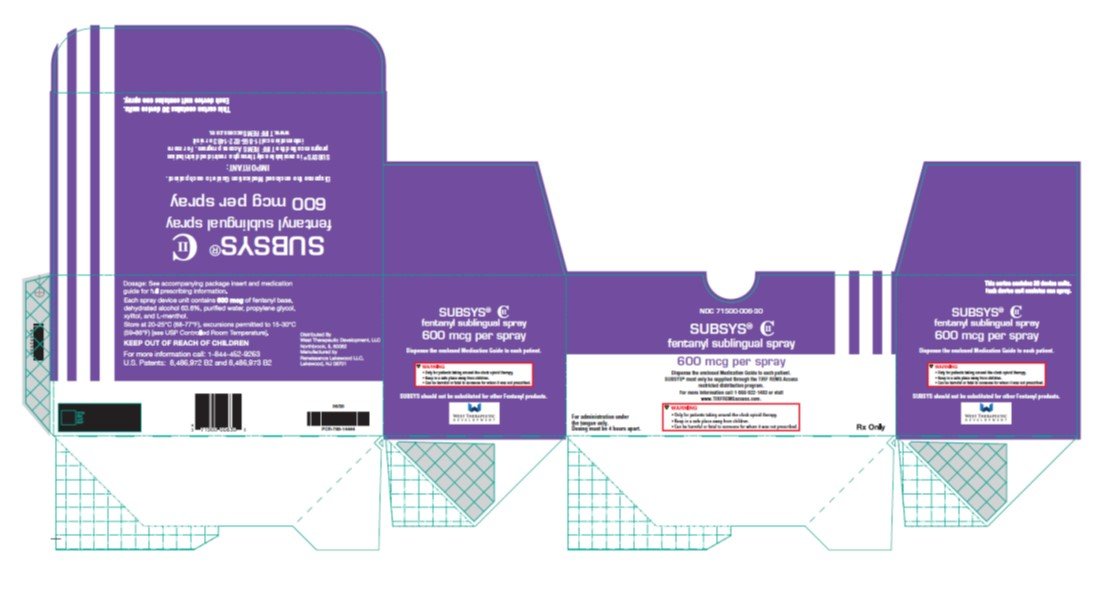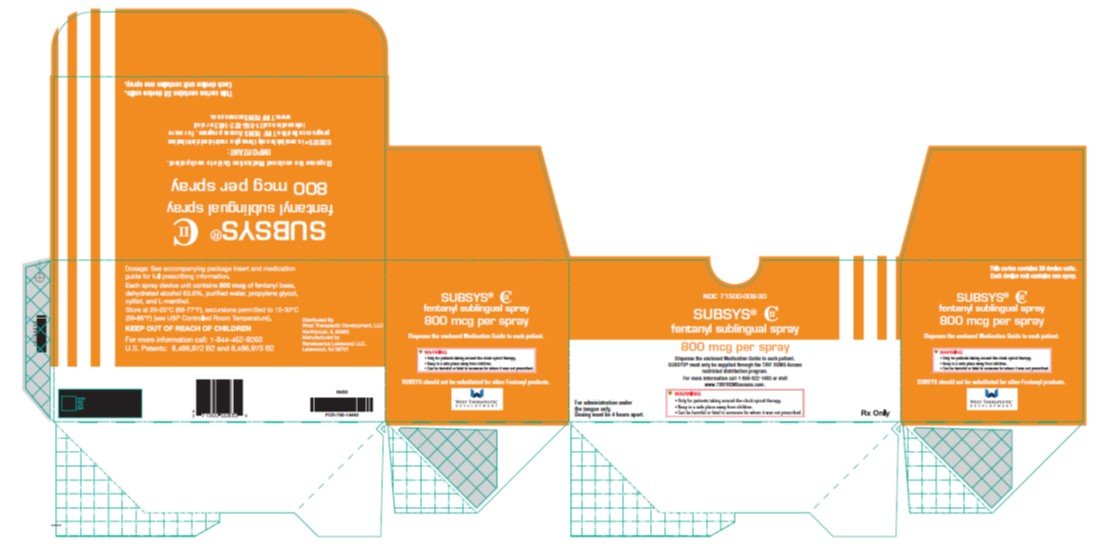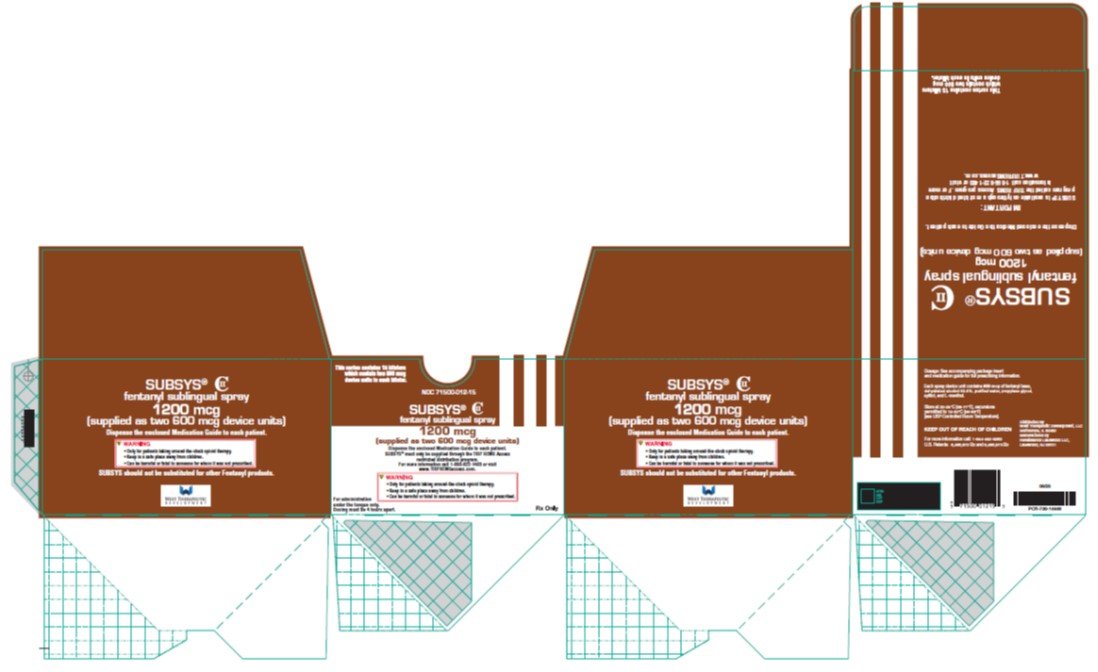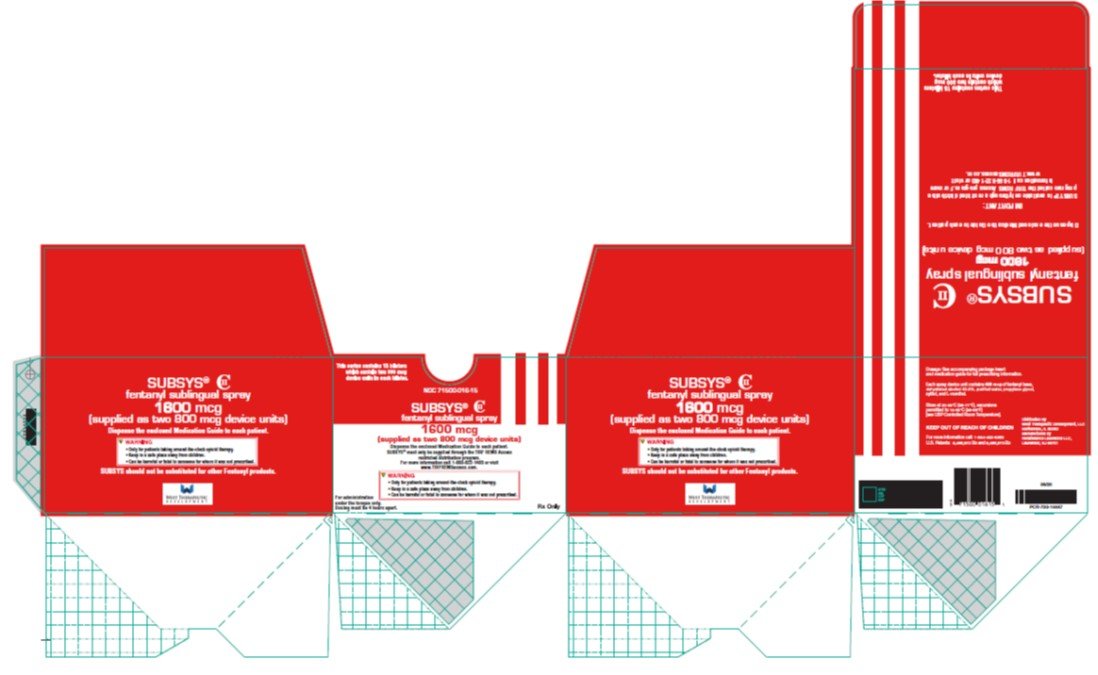Subsys: Package Insert / Prescribing Info
Package insert / product label
Generic name: fentanyl
Dosage form: sublingual spray
Drug class: Opioids (narcotic analgesics)
Medically reviewed by Drugs.com. Last updated on Apr 23, 2025.
On This Page
- Indications and Usage
- Dosage and Administration
- Dosage Forms and Strengths
- Contraindications
- Warnings and Precautions
- Adverse Reactions/Side Effects
- Drug Interactions
- Use In Specific Populations
- Drug Abuse and Dependence
- Overdosage
- Description
- Clinical Pharmacology
- Nonclinical Toxicology
- Clinical Studies
- How Supplied/Storage and Handling
- Patient Counseling Information
- Medication Guide
Highlights of Prescribing Information
SUBSYS®(fentanyl sublingual spray), CII
Initial U.S. Approval: 1968
WARNING: LIFE-THREATENING RESPIRATORY DEPRESSION, ACCIDENTAL INGESTION; CYTOCHROME P450 3A4 INTERACTION; RISKS FROM CONCOMITANT USE WITH BENZODIAZEPINES OR OTHER CNS DEPRESSANTS; RISK OF MEDICATION ERRORS; ADDICTION, ABUSE, AND MISUSE; REMS; and NEONATAL OPIOID WITHDRAWAL SYNDROME
See full prescribing information for complete boxed warning.
- Serious, life-threatening, and/or fatal respiratory depression has occurred. Monitor closely, especially upon initiation or following a dose increase. Due to the risk of fatal respiratory depression, SUBSYS is contraindicated in opioid non-tolerant patients ( 1) and in management of acute or postoperative pain, including headache/migraines. ( 5.1)
- Accidental ingestion of SUBSYS, especially by children, can result in a fatal overdose of fentanyl. Keep out of reach of children. Ensure proper storage and disposal. ( 5.2)
- Concomitant use with CYP3A4 inhibitors (or discontinuation of CYP3A4 inducers) can result in a fatal overdose of fentanyl. ( 5.3, 7, 12.2)
- Concomitant use of opioids with benzodiazepines or other central nervous system (CNS) depressants, including alcohol, may result in profound sedation, respiratory depression, coma, and death. Reserve concomitant prescribing for use in patients for whom alternative treatment options are inadequate; limit dosages and durations to the minimum required and follow patients for signs and symptoms of respiratory depression and sedation. ( 5.4, 7)
- When prescribing, do not convert patients on a mcg per mcg basis from any other oral transmucosal fentanyl product to SUBSYS. ( 2.2, 5.5)
- When dispensing, do not substitute with any other fentanyl products. ( 5.5)
- SUBSYS exposes users to risks of addiction, abuse, and misuse, which can lead to overdose and death. Assess patient’s risk before prescribing and monitor regularly for these behaviors and conditions. ( 5.6)
- SUBSYS is available only through a restricted program called the TIRF REMS. Pharmacies, outpatients, and healthcare professionals who prescribe to outpatients are required to enroll in the program. Patients must be opioid tolerant to receive a TIRF medicine. ( 5.7)
- Prolonged use of SUBSYS during pregnancy can result in neonatal opioid withdrawal syndrome, which may be life-threatening if not recognized and treated. If prolonged opioid use is required in a pregnant woman, advise the patient of the risk of neonatal opioid withdrawal syndrome and ensure that appropriate treatment will be available. ( 5.8)
Recent Major Changes
| Boxed Warning | 03/2021 |
| Dosage and Administration(2.2) | 03/2021 |
| Warnings and Precautions (5.1, 5.4, 5.6, 5.7) | 03/2021 |
Indications and Usage for Subsys
SUBSYS is an opioid agonist indicated for the management of breakthrough pain in cancer patients 18 years of age and older who are already receiving and who are tolerant to around-the-clock opioid therapy for their underlying persistent cancer pain. ( 1)
Patients considered opioid tolerant are those who are taking, for one week or longer, around-the-clock medicine consisting of at least 60 mg of oral morphine per day, at least 25 mcg of transdermal fentanyl per hour, at least 30 mg of oral oxycodone per day, at least 8 mg of oral hydromorphone per day, at least 25 mg oral oxymorphone per day, at least 60 mg oral hydrocodone per day, or an equianalgesic dose of another opioid daily for a week or longer. Patients must remain on around-the-clock opioids when taking SUBSYS.
Limitations of Use ( 1):
- Not for use in opioid non-tolerant patients.
- Not for use in the management of acute or postoperative pain, including headache/migraine, dental pain, or in the emergency room.
- As a part of the Transmucosal Immediate-Release Fentanyl (TIRF) REMS, SUBSYS may be dispensed by outpatient pharmacies only to outpatients enrolled in the program (
5.7). For inpatient administration of SUBSYS, patient and prescriber enrollment are not required.
Subsys Dosage and Administration
- Patients must require and use around-the-clock opioids when taking SUBSYS. ( 1)
- Use the lowest effective dose for the shortest duration consistent with individual patient treatment goals ( 2.1)
- Individualize dosing based on the severity of pain, patient response, prior analgesic experience, and risk factors for addiction, abuse, and misuse. ( 2.1)
- Initiate treatment with 100 mcg except patients already using Actiq. ( 2.2)
- Individually titrate to a tolerable dose that provides adequate analgesia using a single SUBSYS dose per breakthrough cancer pain episode. ( 2.4)
- No more than two doses can be taken per breakthrough pain episode. ( 2.4)
- Wait at least 4 hours before treating another episode of breakthrough pain with SUBSYS. ( 2.4)
- Limit consumption to four or fewer doses per day once successful dose is found. ( 2.4)
- When opioid therapy is no longer required, consider discontinuing SUBSYS along with a gradual downward titration of other opioids to minimize possible withdrawal effects. ( 2.5).
Dosage Forms and Strengths
Sublingual spray in 100 mcg, 200 mcg, 400 mcg, 600 mcg, 800 mcg dosage strengths. ( 3)
Contraindications
- Opioid non-tolerant patients. ( 4)
- Management of acute or postoperative pain including headache/migraine and dental pain, or in emergency department. ( 4)
- Acute or severe bronchial asthma in an unmonitored setting or in absence of resuscitative equipment. ( 4)
- Known or suspected gastrointestinal obstruction, including paralytic ileus. ( 4)
- Known hypersensitivity to fentanyl, or components of SUBSYS. ( 4)
Warnings and Precautions
- Life-Threatening Respiratory Depression in Patients with Chronic Pulmonary Disease or in Elderly, Cachectic, or Debilitated Patients: Monitor closely, particularly during initiation and titration. ( 5.9)
- Serotonin Syndrome: Potentially life-threatening condition could result from concomitant serotonergic drug administration. Discontinue SUBSYS if serotonin syndrome is suspected. ( 5.10)
- Adrenal Insufficiency: If diagnosed, treat with physiologic replacement of corticosteroids, and wean patient off of the opioid. ( 5.11)
- Severe Hypotension: Monitor during dosage initiation and titration. Avoid use of SUBSYS in patients with circulatory shock. ( 5.12)
- Risks of Use in Patients with Increased Intracranial Pressure, Brain Tumors, Head Injury, or Impaired Consciousness: Monitor for sedation and respiratory depression. Avoid use of SUBSYS in patients with impaired consciousness or coma. ( 5.13)
Adverse Reactions/Side Effects
Most common adverse reactions during treatment (incidence ≥ 5%): vomiting, nausea, constipation, dyspnea, and somnolence. ( 6)
To report SUSPECTED ADVERSE REACTIONS, contact West Therapeutic Development, LLC., at 1-844-452-9263 or FDA at 1-800-FDA-1088 or www.fda.gov/medwatch.
Drug Interactions
- Mixed Agonist/Antagonist and Partial Agonist Opioid Analgesics: Avoid use with SUBSYS because they may reduce analgesic effect of SUBSYS or precipitate withdrawal symptoms. ( 7)
Use In Specific Populations
See 17 for PATIENT COUNSELING INFORMATION and Medication Guide.
Revised: 3/2021
Full Prescribing Information
WARNING: LIFE THREATENTING RESPIRATORY DEPRESSION; ACCIDENTAL EXPOSURE, CYTOCHROME P450 3A4 INTERACTION; RISKS FROM CONCOMITANT USE WITH BENZODIAZEPINES OR OTHER CNS DEPRESSANTS; RISK OF MEDICATION ERRORS; ADDICTION, ABUSE, AND MISUSE; REMS; and NEONATAL OPIOID WITHDRAWAL SYNDROME
Life-Threatening Respiratory Depression
Serious, life-threatening, and/or fatal respiratory depression has occurred in patients treated with SUBSYS, including following use in opioid non-tolerant patients and improper dosing. Monitor for respiratory depression, especially during initiation of SUBSYS or following a dose increase. The substitution of SUBSYS for any other fentanyl product may result in fatal overdose
[see Warnings and Precautions (
5.1)]
Due to the risk of respiratory depression, SUBSYS is contraindicated in the management of acute or postoperative pain including headache/migraine and in opioid non-tolerant patients. [see Contraindications ( 4)]
Accidental INGESTION
Accidental ingestion of even one dose of SUBSYS especially by children, can result in a fatal overdose of fentanyl
[see Warnings and Precautions (
5.2 )]
.
Death has been reported in children who have accidentally ingested transmucosal immediate-release fentanyl products. SUBSYS must be kept out of reach of children [see Warnings and Precautions ( 5.2); How Supplied/Storage and Handling ( 16)].
Cytochrome P450 3A4 Interaction
The concomitant use of SUBSYS with all cytochrome P450 3A4 inhibitors may result in an increase in fentanyl plasma concentrations, which could increase or prolong adverse reactions and may cause potentially fatal respiratory depression. In addition, discontinuation of a concomitantly used cytochrome P450 3A4 inducer may result in an increase in fentanyl plasma concentration. Monitor patients receiving SUBSYS and any CYP3A4 inhibitor or inducer
[see Warnings and Precautions (
5.3), Drug Interactions (
7), Clinical Pharmacology (
12.3)]
.
Risks From Concomitant Use With Benzodiazepines Or Other CNS Depressants
Concomitant use of opioids with benzodiazepines or other central nervous system (CNS) depressants, including alcohol, may result in profound sedation, respiratory depression, coma, and death
[see Warnings and Precautions (
5.4), Drug Interactions (
7)].
- Reserve concomitant prescribing of SUBSYS and benzodiazepines or other CNS depressants for use in patients for whom alternative treatment options are inadequate.
- Limit dosages and durations to the minimum required.
- Follow patients for signs and symptoms of respiratory depression and sedation.
Risk of Medication Errors
Substantial differences exist in the pharmacokinetic profile of SUBSYS compared to other fentanyl products that result in clinically important differences in the extent of absorption of fentanyl that could result in fatal overdose
[see Dosage and Administration (
2.1), Warnings and Precautions (
5.5)]
.
- When prescribing, do not convert patients on a mcg per mcg basis from any other fentanyl products to SUBSYS.
- When dispensing, do not substitute a SUBSYS prescription for other fentanyl products.
Addiction, Abuse, and Misuse
SUBSYS exposes patients and other users to the risks of opioid addiction, abuse, and misuse, which can lead to overdose and death. Assess each patient’s risk prior to prescribing SUBSYS, and monitor all patients regularly for the development of these behaviors and conditions
[see Warnings and Precautions (
5.6)]
.
Risk Evaluation and Mitigation Strategy (REMS) Access Program
Because of the risk for accidental exposure, misuse, abuse, addiction, and overdose, SUBSYS is available only through a restricted program required by the Food and Drug Administration, called a Risk Evaluation and Mitigation Strategy (REMS). Under the Transmucosal Immediate Release Fentanyl (TIRF) REMS, pharmacies, outpatients, and healthcare professionals who prescribe to outpatients must enroll in the program. Inpatient pharmacies must develop policies and procedures to verify opioid tolerance in inpatients who require SUBSYS while hospitalized [see Warnings and Precautions (
5.7)]. Further information is available at www.TIRFREMSaccess.com or by calling 1-866-822-1483.
Neonatal Opioid Withdrawal Syndrome
Prolonged use of SUBSYS during pregnancy can result in neonatal opioid withdrawal syndrome, which may be life-threatening if not recognized and treated, and requires management according to protocols developed by neonatology experts. If opioid use is required for a prolonged period in a pregnant woman, advise the patient of the risk of neonatal opioid withdrawal syndrome and ensure that appropriate treatment will be available [
see Warnings and Precautions (
5.8)
].
1. Indications and Usage for Subsys
SUBSYS is indicated for the management of breakthrough pain in cancer patients 18 years of age and older who are already receiving and who are tolerant to around-the-clock opioid therapy for their underlying persistent cancer pain.
Patients considered opioid tolerant are those who are taking for one week or longer, around-the-clock medicine consisting of at least 60 mg of oral morphine per day, at least 25 mcg of transdermal fentanyl per hour, at least 30 mg of oral oxycodone per day, at least 8 mg of oral hydromorphone per day, or at least 25 mg oral oxymorphone per day, or at least 60mg oral hydrocodone per day, or an equianalgesic dose of another opioid daily for a week or longer. Patients must remain on around-the-clock opioids when taking SUBSYS.
Limitations of Use:
- Not for use in opioid non-tolerant patients.
- Not for use in the management of acute or postoperative pain, including headache/migraine, dental pain, or in the emergency room [see Contraindications ( 4)].
- As part of the Transmucosal Immediate-Release Fentanyl (TIRF) REMS, SUBSYS may be dispensed by outpatient pharmacies only to outpatients enrolled in the program. [ see Warnings and Precautions ( 5.7)]. For inpatient administration of SUBSYS, patient and prescriber enrollment are not required.
2. Subsys Dosage and Administration
2.1 Important Dosage and Administration Instructions
- Healthcare professionals who prescribe SUBSYS for outpatients must enroll in the TIRF REMS and comply with the requirements of the REMS to ensure safe use of SUBSYS. [see Warnings and Precautions ( 5.7)]
- Use the lowest effective dosage for the shortest duration consistent with individual patient treatment goals [see Warnings and Precautions ( 5)].
- It is important to minimize the number of strengths available to patients at any time to prevent confusion and possible overdose.
- Initiate the dosing regimen for each patient individually, taking into account the patient's severity of pain, patient response, prior analgesic treatment experience, and risk factors for addiction, abuse, and misuse [see Warnings and Precautions ( 5.6)] .
- Monitor patients closely for respiratory depression, especially within the first 24-72 hours of initiating therapy and following dosage increases with SUBSYS and adjust the dosage accordingly [see Warnings and Precautions ( 5.1)].
- Instruct patients and caregivers to take steps to store SUBSYS securely and to properly dispose of unused SUBSYS as soon as no longer needed [see Warnings and Precautions ( 5.2, 5.6), Patient Counseling Information ( 17)].
- Other TIRF formulations and SUBSYS are not equivalent. DO NOT substitute a SUBSYS prescription for any other TIRF formulation under any circumstances. Do not convert patients on a mcg per mcg basis from any other fentanyl product to SUBSYS [see Warnings and Precautions ( 5.5)]
- SUBSYS is not bioequivalent with other fentanyl products. Do not convert patients on a mcg per mcg basis from other fentanyl products. There are no conversion directions available for patients on any other fentanyl products, other than Actiq. (Note: This includes oral, transdermal, or parenteral formulations of fentanyl.) [see Warnings and Precautions ( 5.5)].
- SUBSYS is NOT a generic version of any other oral transmucosal fentanyl product [see Warnings and Precautions ( 5.5)] .
2.2 Patient Access to Naloxone for the Emergency Treatment of Opioid Overdose
Discuss the availability of naloxone for the emergency treatment of opioid overdose with the patient and caregiver and assess the potential need for access to naloxone, both when initiating and renewing treatment with SUBSYS [ see Warnings and Precautions ( 5.1) , Patient Counseling Information ( 17) ].
Inform patients and caregivers about the various ways to obtain naloxone as permitted by individual state naloxone dispensing and prescribing requirements or guidelines (e.g., by prescription, directly from a pharmacist, or as part of a community-based program).
Consider prescribing naloxone, based on the patient’s risk factors for overdose, such as concomitant use of CNS depressants, a history of opioid use disorder, or prior opioid overdose. The presence of risk factors for overdose should not prevent the proper management of pain in any given patient [ see Warnings and Precautions ( 5.1, 5.4, 5.6) ].
Consider prescribing naloxone if the patient has household members (including children) or other close contacts at risk for accidental ingestion or overdose.
2.3 Initial Dosage
Initiate treatment with SUBSYS for all patients (including those switching from another fentanyl product) using ONE 100 mcg spray sublingually.
Prescribe an initial titration supply of 100 mcg SUBSYS units, which limits the number of units in the home during titration.
Avoid prescribing a higher dose until patients have used up all units to prevent confusion and possible overdose.
Conversion from Actiq to SUBSYS
The initial dose of SUBSYS is always 100 mcg with the only exception of patients already using Actiq.
- For patients being converted from Actiq, prescribers must use the Initial Dosing Recommendations for Patients on Actiq table below (
Table 1). Patients must be instructed to stop the use of Actiq and dispose of any remaining units.
Table 1. Initial Dosing Recommendations for Patients on ACTIQ Current ACTIQ
Dose
(mcg)Initial SUBSYS Dose
(mcg)200 100 mcg spray 400 100 mcg spray 600 200 mcg spray 800 200 mcg spray 1200 400 mcg spray 1600 400 mcg spray - For patients converting from Actiq doses 400 mcg and below, titration should be initiated with 100 mcg SUBSYS and should proceed using multiples of this strength.
- For patients converting from Actiq doses of 600 and 800 mcg, titration should be initiated with 200 mcg SUBSYS and should proceed using multiples of this strength.
- For patients converting from Actiq doses of 1200 and 1600 mcg, titration should be initiated with 400 mcg SUBSYS and should proceed using multiples of this strength.
2.4 Dosage Modifications in Patients with Oral Mucositis
In cancer patients with mucositis, exposure to SUBSYS was greater than in patients without mucositis. For patients with Grade 1 mucositis, the increased maximum serum concentration and overall exposure requires closer monitoring for respiratory depression and central nervous system depression, particularly during initiation of therapy with SUBSYS. For patients with Grade 2 mucositis or higher, avoid use of SUBSYS unless the benefits outweigh the potential risk of respiratory depression from increased exposure. [see Clinical Pharmacology ( 12.3)]
2.5 Titration and Maintenance of Therapy
Individually titrate SUBSYS to a dose that provides adequate analgesia and minimizes adverse reactions.
- From the 100 mcg initial dose, closely follow patients and change the dosage level until the patient reaches a dose that provides adequate analgesia using a single SUBSYS dose per breakthrough cancer pain episode with tolerable side effects. Patients should record their use of SUBSYS over several episodes of breakthrough cancer pain and review their experience with their physicians to determine if a dosage adjustment is warranted.
- For each breakthrough pain episode treated, if pain is not relieved after 30 minutes, patients may take ONLY ONE additional dose of the same strength for that episode. Thus patients should take a maximum of two doses of SUBSYS for any breakthrough pain episode.
- Patients MUST wait at least 4 hours before treating another episode of breakthrough pain with SUBSYS.
- If there is a need to titrate to a 200 mcg dose, prescribe 200 mcg SUBSYS units.
- Subsequent titration steps are 400 mcg, 600 mcg, 800 mcg, 1200 mcg and 1600 mcg. See Table 2.
- To reduce the risk of overdose during titration, patients should have only one strength of SUBSYS available at any time.
| SUBSYS DOSE | Using |
| 100 mcg | 1 × 100 mcg unit |
| 200 mcg | 1 × 200 mcg unit |
| 400 mcg | 1 × 400 mcg unit |
| 600 mcg | 1 × 600 mcg unit |
| 800 mcg | 1 × 800 mcg unit |
| 1200 mcg | 2 × 600 mcg unit |
| 1600 mcg | 2 × 800 mcg unit |
SUBSYS Titration Process
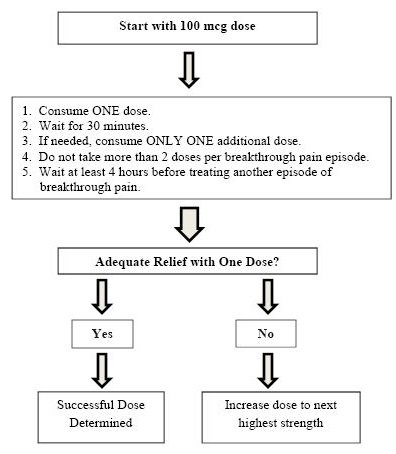
Once titrated to a dose that provides adequate pain relief and tolerable side effects, patients should generally use ONLY ONE SUBSYS dose of the appropriate strength per breakthrough pain episode.
On those occasions when the breakthrough pain episode is not relieved within 30 minutes after administration of the SUBSYS dose, the patient may take ONLY ONE additional dose using the same strength for that episode.
Patients MUST wait at least 4 hours before treating another episode of breakthrough pain with SUBSYS. Once a successful dose has been found, patients should limit consumption to four or fewer doses per day.
Dosage adjustment of SUBSYS may be required in some patients in order to continue to provide adequate relief of breakthrough pain.
If signs of excessive opioid effects appear following administration of a single SUBSYS dose, subsequent doses should be decreased.
Generally, only increase the SUBSYS dose when a single administration of the current dose fails to adequately treat the breakthrough pain episode for several consecutive episodes.
If the patient experiences greater than four breakthrough pain episodes per day, the dose of the maintenance (around-the-clock) opioid used for persistent pain should be re-evaluated. In addition, if pain worsens, re-evaluate the patient for changes in the underlying pain condition.
2.6 Discontinuation of SUBSYS
For patients no longer requiring opioid therapy, consider discontinuing SUBSYS along with a gradual downward titration of other opioids to minimize possible withdrawal effects. In patients who continue to take their chronic opioid therapy for persistent pain but no longer require treatment for breakthrough pain, SUBSYS therapy can usually be discontinued immediately. [ see Drug Abuse and Dependence ( 9.3) ].
2.7 Disposal of SUBSYS
Patients and caregivers must be advised to dispose of used unit dose systems immediately after use and any unneeded unit dose systems remaining from a prescription as soon as they are no longer needed. Consumed units represent a special risk because they are no longer protected by the child resistant blister package, yet may contain enough medicine to be fatal to a child. [see Patient Counseling Information ( 17)].
Charcoal-lined disposal pouches are provided with every carton dispensed. A charcoal-lined disposal pouch is to be used by patients or their caregivers to dispose of the contents of any unneeded unit dose systems when they are no longer needed. Instructions for usage of the charcoal-lined disposal pouch are included in the Medication Guide and Instructions for Use.
3. Dosage Forms and Strengths
SUBSYS is a sublingual spray available in 100 mcg, 200 mcg, 400 mcg, 600 mcg, 800 mcg, 1200 mcg, and 1600 mcg strengths. SUBSYS is supplied as spray units consisting of a white actuator attached to a light purple vial holder [see How Supplied/Storage and Handling ( 16)] . 100 mcg, 200 mcg, 400 mcg, 600 mcg, and 800 mcg doses are delivered as a single unit (spray). To administer 1200 mcg and 1600 mcg doses, two units (sprays) must be used.
Each dosage strength is differentiated by the color of the blister package, and carton as described below in Table 3. The strength of the spray unit is indicated on the actuator.
| Dosage Strength (fentanyl base) | Using | Carton/Blister Package Color |
| 100 mcg | 1 × 100 mcg unit packaged in a single blister | Blue |
| 200 mcg | 1 × 200 mcg unit packaged in a single blister | Green |
| 400 mcg | 1 × 400 mcg unit packaged in a single blister | Magenta (Pink) |
| 600 mcg | 1 × 600 mcg unit packaged in a single blister | Purple |
| 800 mcg | 1 × 800 mcg unit packaged in a single blister | Orange |
| 1200 mcg | 2 × 600 mcg units packaged in a single blister | Brown |
| 1600 mcg | 2 × 800 mcg units packaged in a single blister | Red |
4. Contraindications
SUBSYS is contraindicated in:
- Opioid non-tolerant patients: Life-threatening respiratory depression and death could occur at any dose in opioid non-tolerant patients [see Indications and Usage ( 1); Warnings and Precautions ( 5.1)] .
- Acute or postoperative pain including headache/migraine and dental pain, or in the emergency department [see Indications and Usage ( 1)] .
- Acute or severe bronchial asthma in an unmonitored setting or in the absence of resuscitative equipment [see Warnings and Precautions ( 5.9)].
- Known or suspected gastrointestinal obstruction, including paralytic ileus [see Warnings and Precautions ( 5.14)].
- Known hypersensitivity (e.g., anaphylaxis) to fentanyl or components of SUBSYS [see Adverse Reactions ( 6.2)] .
5. Warnings and Precautions
5.1 Life-Threatening Respiratory Depression
Serious, life-threatening, or fatal respiratory depression has been reported with the use of opioids, even when used as recommended. Respiratory depression, if not immediately recognized and treated, may lead to respiratory arrest and death. Management of respiratory depression may include close observation, supportive measures, and use of opioid antagonists, depending on the patient’s clinical status [see Overdosage (10)] . Carbon dioxide (CO 2) retention from opioid-induced respiratory depression can exacerbate the sedating effects of opioids.
While serious, life-threatening, or fatal respiratory depression can occur at any time during the use of SUBSYS, the risk is greatest during the initiation of therapy or following a dosage increase. Monitor patients closely for respiratory depression, especially within the first 24-72 hours of initiating therapy with and following dosage increases of SUBSYS.
To reduce the risk of respiratory depression, proper dosing and titration of SUBSYS are essential [see Dosage and Administration (2.5)] . Overestimating the SUBSYS dosage can result in a fatal overdose with the first dose. The substitution of SUBSYS for any other fentanyl product may result in fatal overdose [see Warnings and Precautions (5.5)].
SUBSYS could be fatal to individuals for whom it is not prescribed and for those who are not opioid-tolerant.
Accidental ingestion or exposure to even one dose of SUBSYS, especially in children, can result in respiratory depression and death due to an overdose of fentanyl.
Educate patients and caregivers on how to recognize respiratory depression and emphasize the importance of calling 911 or getting emergency medical help right away in the event of a known or suspected overdose [ see Patient Counseling Information (17)].
Opioids can cause sleep-related breathing disorders including central sleep apnea (CSA) and sleep-related hypoxemia. Opioid use increases the risk of CSA in a dose-dependent fashion. In patients who present with CSA, consider decreasing the opioid dosage using best practices for opioid taper [see Dosage and Administration ( 2.5)].
Patient Access to Naloxone for the Emergency Treatment of Opioid Overdose
Discuss the availability of naloxone for the emergency treatment of opioid overdose with the patient and caregiver and assess the potential need for access to naloxone, both when initiating and renewing treatment with SUBSYS. Inform patients and caregivers about the various ways to obtain naloxone as permitted by individual state naloxone dispensing and prescribing requirements or guidelines (e.g., by prescription, directly from a pharmacist, or as part of a community-based program). Educate patients and caregivers on how to recognize respiratory depression and emphasize the importance of calling 911 or getting emergency medical help, even if naloxone is administered [ see Patient Counseling Information (17)].
Consider prescribing naloxone, based on the patient’s risk factors for overdose, such as concomitant use of CNS depressants, a history of opioid use disorder, or prior opioid overdose. The presence of risk factors for overdose should not prevent the proper management of pain in any given patient. Also consider prescribing naloxone if the patient has household members (including children) or other close contacts at risk for accidental ingestion or overdose. If naloxone is prescribed, educate patients and caregivers on how to treat with naloxone. [ see Warnings and Precautions (5.4, 5.6), Patient Counseling Information (17)].
5.2 Increased Risk of Overdose in Children Due to Accidental Ingestion
Death has been reported in children who have accidentally ingested transmucosal immediate–release fentanyl products.
Patients and their caregivers must be informed that SUBSYS contains a medicine in an amount which can be fatal to a child. Physicians and dispensing pharmacists must specifically question patients or caregivers about the presence of children in the home (on a full time or visiting basis) and counsel them regarding the dangers to children from inadvertent exposure.
Patients and their caregivers must be instructed to keep both used and unused dosage units out of the reach of children. While all units should be disposed of immediately after use, partially consumed units represent a special risk to children. In the event that a unit is not completely consumed it must be properly disposed as soon as possible [ see Patient Counseling Information ( 17) ].
Detailed instructions for the proper storage, administration, disposal, and important instructions for managing an overdose of SUBSYS are provided in the SUBSYS Medication Guide. Encourage patients to read this information in its entirety and give them an opportunity to have their questions answered.
5.3 Risks of Concomitant Use or Discontinuation of Cytochrome P450 3A4 Inhibitors and Inducers
Concomitant use of SUBSYS with a CYP3A4 inhibitor, such as macrolide antibiotics (e.g., erythromycin), azole-antifungal agents (e.g., ketoconazole), and protease inhibitors (e.g., ritonavir), may increase plasma concentrations of fentanyl and prolong opioid adverse reactions, which may cause potentially fatal respiratory depression [ see Warnings and Precautions ( 5.9) ], particularly when an inhibitor is added after a stable dose of SUBSYS is achieved. Similarly, discontinuation of a CYP3A4 inducer, such as rifampin, carbamazepine, and phenytoin, in SUBSYS-treated patients may increase fentanyl plasma concentrations and prolong opioid adverse reactions. When using SUBSYS with CYP3A4 inhibitors or discontinuing CYP3A4 inducers in SUBSYS-treated patients, monitor patients closely at frequent intervals and consider dosage reduction of SUBSYS until stable drug effects are achieved [see Drug Interactions ( 7)] .
Concomitant use of SUBSYS with CYP3A4 inducers or discontinuation of an CYP3A4 inhibitor could decrease fentanyl plasma concentrations, decrease opioid efficacy or, possibly, lead to a withdrawal syndrome in a patient who had developed physical dependence to fentanyl. When using SUBSYS with CYP3A4 inducers or discontinuing CYP3A4 inhibitors, monitor patients closely at frequent intervals and consider increasing the opioid dosage if needed to maintain adequate analgesia or if symptoms of opioid withdrawal occur [ see Drug Interactions ( 7)] .
5.4 Risks from Concomitant Use with Benzodiazepines or Other CNS Depressants
Profound sedation, respiratory depression, coma, and death may result from the concomitant use of SUBSYS with benzodiazepines or other CNS depressants (e.g., non-benzodiazepine sedatives/hypnotics, anxiolytics, tranquilizers, muscle relaxants, general anesthetics, antipsychotics, other opioids, alcohol). Because of these risks, reserve concomitant prescribing of these drugs for use in patients for whom alternative treatment options are inadequate.
Observational studies have demonstrated that concomitant use of opioid analgesics and benzodiazepines increases the risk of drug-related mortality compared to use of opioid analgesics alone. Because of similar pharmacological properties, it is reasonable to expect similar risk with the concomitant use of other CNS depressant drugs with opioid analgesics [see Drug Interactions ( 7)] .
If the decision is made to prescribe a benzodiazepine or other CNS depressant concomitantly with an opioid analgesic, prescribe the lowest effective dosages and minimum durations of concomitant use. In patients already receiving an opioid analgesic, prescribe a lower initial dose of the benzodiazepine or other CNS depressant than indicated in the absence of an opioid, and titrate based on clinical response. If an opioid analgesic is initiated in a patient already taking a benzodiazepine or other CNS depressant, prescribe a lower initial dose of the opioid analgesic, and titrate based on clinical response. Follow patients closely for signs and symptoms of respiratory depression and sedation.
If concomitant use is warranted, consider prescribing naloxone for the emergency treatment of opioid overdose [see Dosage and Administration ( 2.2), Warnings and Precautions ( 5.1) ].
Advise both patients and caregivers about the risks of respiratory depression and sedation when SUBSYS is used with benzodiazepines or other CNS depressants (including alcohol and illicit drugs). Advise patients not to drive or operate heavy machinery until the effects of concomitant use of the benzodiazepine or other CNS depressant have been determined. Screen patients for risk of substance use disorders, including opioid abuse and misuse, and warn them of the risk for overdose and death associated with the use of additional CNS depressants including alcohol and illicit drugs [see Drug Interactions ( 7) and Patient Counseling Information ( 17)].
5.5 Risk of Medication Errors
When prescribing, DO NOT convert a patient to SUBSYS from any other fentanyl product on a mcg per mcg basis as SUBSYS and other fentanyl products are not equivalent on a microgram per microgram basis.
SUBSYS is NOT a generic version of other transmucosal immediate release fentanyl (TIRF) formulations. When dispensing, DO NOT substitute a SUBSYS prescription for any other TIRF formulation under any circumstances. Other TIRF formulations and SUBSYS are not equivalent. Substantial differences exist in the pharmacokinetic profile of SUBSYS compared to other fentanyl products including other TIRF formulations that result in clinically important differences in the rate and extent of absorption of fentanyl. As a result of these differences, the substitution of SUBSYS for any other fentanyl product may result in a fatal overdose.
There are no safe conversion directions available for patients on any other fentanyl products (Note: This includes oral, transdermal, or parenteral formulations of fentanyl.) [see Dosage and Administration ( 2.1)] . Therefore, for opioid tolerant patients, the initial dose of SUBSYS should always be ONE 100 mcg spray. Individually titrate each patient’s dose to provide adequate analgesia while minimizing side effects [see Dosage and Administration ( 2.4)] .
5.6 Addiction, Abuse, and Misuse
SUBSYS contains fentanyl, a Schedule II controlled substance. As an opioid, SUBSYS exposes users to the risks of addiction, abuse, and misuse [see Drug Abuse and Dependence ( 9)].
Although the risk of addiction in any individual is unknown, it can occur in patients appropriately prescribed SUBSYS. Addiction can occur at recommended dosages and if the drug is misused or abused.
Assess each patient’s risk for opioid addiction, abuse, or misuse prior to prescribing SUBSYS, and monitor all patients receiving SUBSYS for the development of these behaviors or conditions. Risks are increased in patients with a personal or family history of substance abuse (including drug or alcohol abuse or addiction) or mental illness (e.g., major depression). The potential for these risks should not, however, prevent the proper management of pain in any given patient. Patients at increased risk may be prescribed opioids such as SUBSYS, but use in such patients necessitates intensive counseling about the risks and proper use of SUBSYS along with intensive monitoring for signs of addiction, abuse, and misuse. Consider prescribing naloxone for the emergency treatment of opioid overdose [ see Dosage and Administration ( 2.2), Warnings and Precautions ( 5.1) ].
Opioids are sought by drug abusers and people with addiction disorders and are subject to criminal diversion. Consider these risks when prescribing or dispensing SUBSYS. Strategies to reduce these risks include prescribing the drug in the smallest appropriate quantity and advising the patient on the proper disposal of unused drug [see Patient Counseling Information ( 17)]. Contact local state professional licensing board or state controlled substances authority for information on how to prevent and detect abuse or diversion of this product.
5.7 Transmucosal Immediate Release Fentanyl (TIRF) Risk Evaluation and Mitigation Strategy (REMS)
Because of the risk of accidental exposure, misuse, abuse, addiction, and overdose [ see Warnings and Precautions ( 5.1) ], SUBSYS is available only through a restricted program under a REMS called the TIRF REMS. Under the TIRF REMS, healthcare professionals who prescribe to outpatients, the outpatients themselves, and pharmacies, are required to enroll in the program.
Notable requirements of the TIRF REMS are:
- Prescribers for outpatient use must be certified with the REMS program by enrolling and completing training. Prescribers must document opioid tolerance with every SUBSYS prescription.
- Outpatients must be enrolled in the REMS program and must be opioid tolerant to receive SUBSYS [ see Dosage and Administration ( 2.1) ].
- Outpatient pharmacies must be certified with the REMS program and verify documentation of opioid tolerance with every SUBSYS prescription.
- Inpatient pharmacies must be certified with the REMS program and develop policies and procedures to verify opioid tolerance in inpatients who require SUBSYS while hospitalized.
- Wholesalers and distributers must enroll in the REMS program and distribute only to certified pharmacies.
- Further information, including a list of certified pharmacies and enrolled distributors, is available at www.tirfremsaccess.com or by calling 1-866-822-1483.
5.8 Neonatal Opioid Withdrawal Syndrome
Prolonged use of SUBSYS during pregnancy can result in withdrawal in the neonate. Neonatal opioid withdrawal syndrome, unlike opioid withdrawal syndrome in adults, may be life-threatening if not recognized and treated, and requires management according to protocols developed by neonatology experts. Observe newborns for signs of neonatal opioid withdrawal syndrome and manage accordingly. Advise pregnant women using opioids for a prolonged period of the risk of neonatal opioid withdrawal syndrome and ensure that appropriate treatment will be available [see Use in Specific Populations ( 8.1), Patient Counseling Information ( 17)].
5.9 Life-Threatening Respiratory Depression in Patients with Chronic Pulmonary Disease or in Elderly, Cachectic, or Debilitated Patients
The use of SUBSYS in patients with acute or severe bronchial asthma in an unmonitored setting or in the absence of resuscitative equipment is contraindicated.
Patients with Chronic Pulmonary Disease: SUBSYS treated patients with significant chronic obstructive pulmonary disease or cor pulmonale, and those with a substantially decreased respiratory reserve, hypoxia, hypercapnia, or pre-existing respiratory depression are at increased risk of decreased respiratory drive including apnea, even at recommended dosages of SUBSYS [see Warnings and Precautions ( 5.1)] .
Elderly, Cachectic, or Debilitated Patients: Life-threatening respiratory depression is more likely to occur in elderly, cachectic, or debilitated patients because they may have altered pharmacokinetics or altered clearance compared to younger, healthier patients [see Warnings and Precautions ( 5.1)] .
Monitor such patients closely, particularly when initiating and titrating SUBSYS and when SUBSYS is given concomitantly with other drugs that depress respiration [see Warnings and Precautions ( 5.9)] . Alternatively, consider the use of non-opioid analgesics in these patients.
5.10 Serotonin Syndrome with Concomitant Use of Serotonergic Drugs
Cases of serotonin syndrome, a potentially life-threatening condition, have been reported during concomitant use of SUBSYS with serotonergic drugs. Serotonergic drugs include selective serotonin reuptake inhibitors (SSRIs), serotonin and norepinephrine reuptake inhibitors (SNRIs), tricyclic antidepressants (TCAs), triptans, 5-HT3 receptor antagonists, drugs that affect the serotonergic neurotransmitter system (e.g., mirtazapine, trazodone, tramadol), certain muscle relaxants (i.e., cyclobenzaprine, metaxalone), and drugs that impair metabolism of serotonin (including MAO inhibitors, both those intended to treat psychiatric disorders and also others, such as linezolid and intravenous methylene blue) [see Drug Interactions ( 7)] . This may occur within the recommended dosage range.
Serotonin syndrome symptoms may include mental status changes (e.g., agitation, hallucinations, coma), autonomic instability (e.g., tachycardia, labile blood pressure, hyperthermia), neuromuscular aberrations (e.g., hyperreflexia, incoordination, rigidity), and/or gastrointestinal symptoms (e.g., nausea, vomiting, diarrhea). The onset of symptoms generally occurs within several hours to a few days of concomitant use, but may occur later than that. Discontinue SUBSYS if serotonin syndrome is suspected.
5.11 Adrenal Insufficiency
Cases of adrenal insufficiency have been reported with opioid use, more often following greater than one month of use. Presentation of adrenal insufficiency may include non-specific symptoms and signs including nausea, vomiting, anorexia, fatigue, weakness, dizziness, and low blood pressure. If adrenal insufficiency is suspected, confirm the diagnosis with diagnostic testing as soon as possible. If adrenal insufficiency is diagnosed, treat with physiologic replacement doses of corticosteroids. Wean the patient off of the opioid to allow adrenal function to recover and continue corticosteroid treatment until adrenal function recovers. Other opioids may be tried as some cases reported use of a different opioid without recurrence of adrenal insufficiency. The information available does not identify any particular opioids as being more likely to be associated with adrenal insufficiency.
5.12 Severe Hypotension
SUBSYS may cause severe hypotension including orthostatic hypotension and syncope in ambulatory patients. There is increased risk in patients whose ability to maintain blood pressure has already been compromised by a reduced blood volume or concurrent administration of certain CNS depressant drugs (e.g. phenothiazines or general anesthetics) [see Drug Interactions ( 7)] . Monitor these patients for signs of hypotension after initiating or titrating the dosage of SUBSYS. In patients with circulatory shock, SUBSYS may cause vasodilation that can further reduce cardiac output and blood pressure. Avoid the use of SUBSYS in patients with circulatory shock.
5.13 Risks of Use in Patients with Increased Intracranial Pressure, Brain Tumors, Head Injury, or Impaired Consciousness
In patients who may be susceptible to the intracranial effects of CO 2 retention (e.g., those with evidence of increased intracranial pressure or brain tumors), SUBSYS may reduce respiratory drive, and the resultant CO 2 retention can further increase intracranial pressure. Monitor such patients for signs of sedation and respiratory depression, particularly when initiating therapy with SUBSYS.
Opioids may also obscure the clinical course in a patient with a head injury. Avoid the use of SUBSYS in patients with impaired consciousness or coma.
5.14 Risks of Use in Patients with Gastrointestinal Conditions
SUBSYS is contraindicated in patients with known or suspected gastrointestinal obstruction, including paralytic ileus.
The fentanyl in SUBSYS may cause spasm of the sphincter of Oddi. Opioids may cause increases in serum amylase. Monitor patients with biliary tract disease, including acute pancreatitis for worsening symptoms.
5.15 Increased Risk of Seizures in Patients with Seizure Disorders
The fentanyl in SUBSYS may increase the frequency of seizures in patients with seizure disorders, and may increase the risk of seizures occurring in other clinical settings associated with seizures. Monitor patients with a history of seizure disorders for worsened seizure control during SUBSYS therapy.
5.16 Risks of Driving and Operating Machinery
SUBSYS may impair the mental or physical abilities needed to perform potentially hazardous activities such as driving a car or operating machinery. Warn patients not to drive or operate dangerous machinery unless they are tolerant to the effects of SUBSYS and know how they will react to the medication.
6. Adverse Reactions/Side Effects
The following serious adverse reactions are described, or described in greater detail, in other sections:
- Life-Threatening Respiratory Depression [see Warnings and Precautions ( 5.1)]
- Interactions with Benzodiazepines and other CNS Depressants [see Warnings and Precautions ( 5.4)
- Addiction, Abuse, and Misuse [see Warnings and Precautions ( 5.6)]
- Neonatal Opioid Withdrawal Syndrome [see Warnings and Precautions ( 5.8)]
- Serotonin Syndrome [see Warnings and Precautions ( 5.10)]
- Adrenal Insufficiency [see Warnings and Precautions ( 5.11)]
- Severe Hypotension [see Warnings and Precautions ( 5.12)]
- Gastrointestinal Adverse Reactions [see Warnings and Precautions ( 5.14)]
- Seizures [see Warnings and Precautions ( 5.15)]
6.1 Clinical Trials Experience
Because clinical trials are conducted under widely varying conditions, adverse reaction rates observed in the clinical trials of a drug cannot be directly compared to rates in the clinical trials of another drug and may not reflect the rates observed in practice.
The safety of SUBSYS has been evaluated in a total of 359 opioid-tolerant patients with breakthrough cancer pain. The duration of SUBSYS use varied during the open-label study. Safety data from a long-term extension study showed that the average duration of therapy in the open-label study was 66 days. The maximum duration of therapy was 149 days. The dose range studied in these trials ranged from 100 mcg per dose to 1600 mcg per dose.
The most serious adverse reactions associated with all opioids including SUBSYS are respiratory depression (potentially leading to apnea or respiratory arrest), circulatory depression, hypotension, and shock. Follow all patients for symptoms of respiratory depression.
The most common adverse reaction leading to discontinuation of SUBSYS was nausea. There were also adverse reactions of abdominal distension, anorexia, confusional state, disorientation, somnolence, and constipation.
The clinical trials of SUBSYS were designed to evaluate safety and efficacy in treating breakthrough cancer pain; all patients were also taking concomitant opioids, such as sustained-release morphine or transdermal fentanyl, for their persistent cancer pain. The adverse event data presented here reflect the actual percentage of patients experiencing each adverse effect among patients who received SUBSYS for breakthrough cancer pain along with a concomitant opioid for persistent cancer pain.
Table 4 lists adverse reactions with an overall frequency of 5% or greater that occurred during titration in the clinical trials. Adverse reactions are listed in descending order of frequency within each system organ class.
| System Organ Class | Titration
n=359 (%) |
|
| Gastrointestinal Disorders | ||
| Nausea | 47 (13.1%) | |
| Vomiting | 37 (10.3%) | |
| Constipation | 18 (5.0%) | |
| Nervous System Disorders | ||
| Somnolence | 34 (9.5%) | |
| Dizziness | 26 (7.2%) | |
| A patient was counted only once within each category. | ||
The following adverse reactions occurred during titration in the clinical trials with an overall frequency of 1% or greater and are listed in descending order of frequency within each system organ class.
Cardiac Disorders: Tachycardia
Gastrointestinal Disorders: Diarrhea, stomatitis, dry mouth
General Disorders and Administration Site Conditions: Application site irritation, pyrexia, edema peripheral, fatigue, asthenia
Metabolism and Nutrition Disorders: Decreased appetite
Nervous System Disorders: Lethargy, sedation, tremor, headache
Psychiatric Disorders: Depression, confusional state, hallucination, insomnia
Respiratory, Thoracic and Mediastinal Disorders: Dyspnea
Skin and Subcutaneous Tissue Disorders: Pruritus
The following reactions occurred during titration in the clinical trials with an overall frequency of less than 1% and are listed in descending order of frequency within each system organ class.
Eye Disorders: Vision blurred, dry eye
Gastrointestinal Disorders: Abdominal pain
Infections and Infestations: Oral candidiasis, cellulitis
Injury, Poisoning and Procedural Complications: Fall
Metabolism and Nutrition Disorders: Dehydration, anorexia
Musculoskeletal and Connective Tissue Disorders: Back pain, arthralgia, joint swelling
Psychiatric Disorders: Anxiety, agitation
Renal and Urinary Disorders: Urinary retention
Respiratory, Thoracic and Mediastinal Disorders: Cough, increased bronchial secretion, dysphonia, pharyngolaryngeal pain
Skin and Subcutaneous Tissue Disorders: Hyperhidrosis
Vascular Disorders: Hot flush
Table 5 lists adverse reactions with an overall frequency of 5% or greater for the total safety database subsequent to titration during the clinical trials.
| System Organ Class | Dosing
n=269 |
|
| Gastrointestinal Disorders | ||
| Vomiting | 43 (16.0%) | |
| Nausea | 28 (10.4%) | |
| Constipation | 28 (10.4%) | |
| General Disorders and Administration Site Conditions | ||
| Asthenia | 26 (9.7%) | |
| Respiratory, Thoracic and Mediastinal Disorders | ||
| Dyspnea | 28 (10.4%) | |
| Psychiatric Disorders | ||
| Anxiety | 16 (5.9%) | |
| A patient was counted only once within each category. | ||
The following adverse reactions occurred during the dosing period of the clinical trial with an overall frequency of 1% or greater and are listed in descending order of frequency within each system organ class.
Blood and Lymphatic System Disorders: Anemia, neutropenia, lymphadenopathy, thrombocytopenia, leukopenia
Cardiac Disorders: Tachycardia, sinus tachycardia
Gastrointestinal Disorders: Diarrhea, stomatitis, abdominal pain, abdominal distension, gastritis, dysphagia, dyspepsia, gastroesophageal reflux disease, ascites, hematemesis
General Disorders and Administration Site Conditions: Edema peripheral, fatigue, pyrexia, chest pain, drug withdrawal syndrome, chills, irritability, malaise, application site irritation
Infections and Infestations: Oral candidiasis, pneumonia, urinary tract infection, oral herpes, gastroenteritis, laryngitis
Injury, Poisoning and Procedural Complications: Contusion
Investigations: Weight decreased, aspartate aminotransferase increased, blood alkaline phosphatase increased, blood glucose increased, blood lactate increased
Metabolism and Nutrition Disorders: Anorexia, dehydration, hypokalemia, decreased appetite, hyponatremia, hypocalcemia, hypoalbuminemia, cachexia
Musculoskeletal and Connective Tissue Disorders: Back pain, arthralgia, muscular weakness
Nervous System Disorders: Hypoesthesia, lethargy, sedation, tremor, somnolence, headache, dizziness
Psychiatric Disorders: Depression, restlessness, agitation, confusional state, insomnia, hallucination, disorientation
Renal and Urinary Disorders: hypertension, hypotension
Respiratory, Thoracic and Mediastinal Disorders: Cough, increased bronchial secretion, wheezing, pharyngolaryngeal pain, hypoxia, dyspnea exertional
Skin and Subcutaneous Tissue Disorders: hyperhidrosis, pruritus
In a single-dose mucositis study, a group of patients with Grade 1 or 2 oral mucositis (n=9) and without oral mucositis (n=9) were included in a clinical trial designed to support the safety of SUBSYS. Two of the nine subjects with mucositis (one with Grade 1 and one with Grade 2) reported a burning sensation in the oral mucosa after treatment. Both of these events were considered mild and probably related to treatment. There was no change in grade of mucositis after treatment for any subject.
6.2 Postmarketing Experience
The following adverse reactions have been identified during post approval use of fentanyl. Because these reactions are reported voluntarily from a population of uncertain size, it is not always possible to reliably estimate their frequency or establish a causal relationship to drug exposure.
Serotonin syndrome: Cases of serotonin syndrome, a potentially life-threatening condition, have been reported during concomitant use of opioids with serotonergic drugs.
Adrenal insufficiency: Cases of adrenal insufficiency have been reported with opioid use, more often following greater than one month of use.
Anaphylaxis: Anaphylaxis has been reported with ingredients contained in SUBSYS.
Androgen deficiency: Cases of androgen deficiency have occurred with chronic use of opioids [see Clinical Pharmacology ( 12.2)] .
Related/similar drugs
7. Drug Interactions
Table 6 includes clinically significant drug interactions with SUBSYS.
| Inhibitors of CYP3A4 | |||
| Clinical Impact: |
The concomitant use of SUBSYS and CYP3A4 inhibitors can increase the plasma concentration of fentanyl, resulting in increased or prolonged opioid effects, particularly when an inhibitor is added after a stable dose of SUBSYS is achieved [see Warnings and Precautions ( 5.3)] . After stopping a CYP3A4 inhibitor, as the effects of the inhibitor decline, the fentanyl plasma concentration will decrease [see Clinical Pharmacology ( 12.3)] , resulting in decreased opioid efficacy or a withdrawal syndrome in patients who had developed physical dependence to fentanyl. |
||
| Intervention: |
If concomitant use is necessary, consider dosage reduction of SUBSYS until stable drug effects are achieved. Monitor patients for respiratory depression and sedation at frequent intervals. If a CYP3A4 inhibitor is discontinued, consider increasing the SUBSYS dosage until stable drug effects are achieved. Monitor for signs of opioid withdrawal. |
||
| Examples | Macrolide antibiotics (e.g., erythromycin), azole-antifungal agents (e.g. ketoconazole), protease inhibitors (e.g., ritonavir) | ||
| CYP3A4 Inducers | |||
| Clinical Impact: |
The concomitant use of SUBSYS and CYP3A4 inducers can decrease the plasma concentration of fentanyl [see Clinical Pharmacology ( 12.3)] , resulting in decreased efficacy or onset of a withdrawal syndrome in patients who have developed physical dependence to fentanyl [see Warnings and Precautions ( 5.3)] . After stopping a CYP3A4 inducer, as the effects of the inducer decline, the fentanyl plasma concentration will increase [see Clinical Pharmacology ( 12.3)] , which could increase or prolong both the therapeutic effects and adverse reactions, and may cause serious respiratory depression. |
||
| Intervention: | If concomitant use is necessary, consider increasing the SUBSYS dosage until stable drug effects are achieved. Monitor for signs of opioid withdrawal. If a CYP3A4 inducer is discontinued, consider SUBSYS dosage reduction and monitor for signs of respiratory depression. | ||
| Examples | Rifampin, carbamazepine, phenytoin | ||
| Benzodiazepines and other Central Nervous System (CNS) Depressants | |||
| Clinical Impact: | Due to additive pharmacologic effect, the concomitant use of benzodiazepines or other CNS depressants including alcohol, increases the risk of respiratory depression, profound sedation, coma, and death. | ||
| Intervention: | Reserve concomitant prescribing of these drugs for use in patients for whom alternative treatment options are inadequate. Limit dosages and durations to the minimum required. Follow patients closely for signs of respiratory depression and sedation [see Warnings and Precautions ( 5.1)] . If concomitant use is warranted, consider prescribing naloxone for the emergency treatment of opioid overdose [ see Dosage and Administration ( 2.2), Warnings and Precautions ( 5.1, 5.4, 5.6) ]. | ||
| Examples: | Benzodiazepines and other sedatives/hypnotics, anxiolytics, tranquilizers, muscle relaxants, general anesthetics, antipsychotics, other opioids, alcohol. | ||
| Serotonergic Drugs | |||
| Clinical Impact: | The concomitant use of opioids with other drugs that affect the serotonergic neurotransmitter system has resulted in serotonin syndrome [see Warnings and Precautions ( 5.10)] . | ||
| Intervention: | If concomitant use is warranted, carefully observe the patient, particularly during treatment initiation and dose adjustment. Discontinue SUBSYS if serotonin syndrome is suspected. | ||
| Examples: | Selective serotonin reuptake inhibitors (SSRIs), serotonin and norepinephrine reuptake inhibitors (SNRIs), tricyclic antidepressants (TCAs), triptans, 5-HT3 receptor antagonists, drugs that effect the serotonin neurotransmitter system (e.g., mirtazapine, trazodone, tramadol), certain muscle relaxants (i.e., cyclobenzaprine, metaxalone), monoamine oxidase (MAO) inhibitors (those intended to treat psychiatric disorders and also others, such as linezolid and intravenous methylene blue). | ||
| Monoamine Oxidase Inhibitors (MAOIs) | |||
| Clinical Impact: | MAOI interactions with opioids may manifest as serotonin syndrome [see Warnings and Precautions ( 5.10)] or opioid toxicity (e.g., respiratory depression, coma) [see Warnings and Precautions ( 5.2)] . | ||
| Intervention: | The use of SUBSYS is not recommended for patients taking MAOIs or within 14 days of stopping such treatment. | ||
| Examples: | phenelzine, tranylcypromine, linezolid | ||
| Mixed Agonist/Antagonist and Partial Agonist Opioid Analgesics | |||
| Clinical Impact: | May reduce the analgesic effect of SUBSYS and/or precipitate withdrawal symptoms. | ||
| Intervention: | Avoid concomitant use. | ||
| Examples: | butorphanol, nalbuphine, pentazocine, buprenorphine, | ||
| Muscle Relaxants | |||
| Clinical Impact: | Fentanyl may enhance the neuromuscular blocking action of skeletal muscle relaxants and produce an increased degree of respiratory depression. | ||
| Intervention: | Monitor patients for signs of respiratory depression that may be greater than otherwise expected and decrease the dosage of SUBSYS and/or the muscle relaxant as necessary. Due to the risk of respiratory depression with concomitant use of skeletal muscle relaxants and opioids, consider prescribing naloxone for the emergency treatment of opioid overdose [ see Dosage and Administration ( 2.2), Warnings and Precautions ( 5.1, 5.4) ] | ||
| Examples: | Cyclobenzaprine, metaxalone | ||
| Diuretics | |||
| Clinical Impact: | Opioids can reduce the efficacy of diuretics by inducing the release of antidiuretic hormone. | ||
| Intervention: | Monitor patients for signs of diminished diuresis and/or effects on blood pressure and increase the dosage of the diuretic as needed. | ||
| Anticholinergic Drugs | |||
| Clinical Impact: | The concomitant use of anticholinergic drugs may increase risk of urinary retention and/or severe constipation, which may lead to paralytic ileus. | ||
| Intervention: | Monitor patients for signs of urinary retention or reduced gastric motility when SUBSYS is used concomitantly with anticholinergic drugs. | ||
8. Use In Specific Populations
8.1 Pregnancy
Risk Summary
Prolonged use of opioid analgesics during pregnancy may cause neonatal opioid withdrawal syndrome [see Warnings and Precautions ( 5.8)] . Available data with SUBSYS in pregnant women are insufficient to inform a drug-associated risk for major birth defects and miscarriage.
In animal reproduction studies, fentanyl administration to pregnant rats during organogenesis was embryocidal at doses within the range of the human recommended dosing. When administered during gestation through lactation fentanyl administration to pregnant rats resulted in reduced pup survival at doses within the range of the human recommended dosing. No evidence of malformations was noted in animal studies completed to date [ see Data].
The estimated background risk of major birth defects and miscarriage for the indicated population is unknown. All pregnancies have a background risk of birth defect, loss, or other adverse outcomes. In the U.S. general population, the estimated background risk of major birth defects and miscarriage in clinically recognized pregnancies is 2-4% and 15-20%, respectively.
Clinical Considerations
Fetal/Neonatal Adverse Reactions
Prolonged use of opioid analgesics during pregnancy for medical or nonmedical purposes can result in physical dependence in the neonate and neonatal opioid withdrawal syndrome shortly after birth. Neonatal opioid withdrawal syndrome presents as irritability, hyperactivity and abnormal sleep pattern, high pitched cry, tremor, vomiting, diarrhea and failure to gain weight. The onset, duration, and severity of neonatal opioid withdrawal syndrome vary based on the specific opioid used, duration of use, timing and amount of last maternal use, and rate of elimination of the drug by the newborn. Observe newborns for symptoms of neonatal opioid withdrawal syndrome and manage accordingly [see Warnings and Precautions ( 5.8)] .
Labor or Delivery
Opioids cross the placenta and may produce respiratory depression and psycho-physiologic effects in neonates. An opioid antagonist, such as naloxone, must be available for reversal of opioid-induced respiratory depression in the neonate. SUBSYS is not recommended for use in pregnant women during or immediately prior to labor, when other analgesic techniques are more appropriate. Opioid analgesics, including SUBSYS, can prolong labor through actions which temporarily reduce the strength, duration, and frequency of uterine contractions. However, this effect is not consistent and may be offset by an increased rate of cervical dilation, which tends to shorten labor. Monitor neonates exposed to opioid analgesics during labor for signs of excess sedation and respiratory depression.
Human Data
In women treated acutely with intravenous or epidural fentanyl during labor, symptoms of neonatal respiratory or neurological depression were no more frequent than would be expected in infants of untreated mothers.
Transient neonatal muscular rigidity has been observed in infants whose mothers were treated with intravenous fentanyl.
Animal Data
Fentanyl has been shown to embryocidal in pregnant rats at doses of 30 mcg/kg intravenously (0.4 times the 800 mcg dose of SUBSYS on a mg/m 2 basis) and 160 mcg/kg subcutaneously (2 times the 800 mcg dose of SUBSYS based on a mg/m 2 basis). There was no evidence of teratogenicity was reported.
No evidence of malformations or adverse effects on the fetus was reported in a published study in which pregnant rats were administered fentanyl continuously via subcutaneously implanted osmotic minipumps at doses of 10, 100, or 500 mcg/kg/day starting 2-weeks prior to breeding and throughout pregnancy. The high dose was approximately 6 times the human dose of 800 mcg SUBSYS per pain episode on a mg/m 2 basis and produced mean steady-state plasma levels that are 5.3 times higher than the mean C max observed following administration of 800 mcg dose of SUBSYS in humans.
8.2 Lactation
Risk Summary
Fentanyl is present in breast milk. One published lactation study reports a relative infant dose of fentanyl of 0.024%. However, there is insufficient information to determine the effects of fentanyl on the breastfed infant and the effects of fentanyl on milk production.
Because of the potential for serious adverse reactions, including excess sedation and respiratory depression in a breastfed infant, advise patients that breastfeeding is not recommended during treatment with SUBSYS.
Clinical Considerations
Monitor infants exposed to SUBSYS through breast milk for excess sedation and respiratory depression. Withdrawal symptoms can occur in breastfed infants when maternal administration of an opioid analgesic is stopped, or when breast-feeding is stopped.
8.3 Females and Males of Reproductive Potential
Infertility
Chronic use of opioids may cause reduced fertility in females and males of reproductive potential. It is not known whether these effects on fertility are reversible [see Adverse Reactions ( 6), Clinical Pharmacology ( 12.2), Nonclinical Toxicology ( 13.1)] .
8.4 Pediatric Use
Safety and efficacy in pediatric patients below the age of 18 years have not been established.
8.5 Geriatric Use
Of the 359 patients in clinical studies of SUBSYS in breakthrough cancer pain, 27% were 60 years of age and older, 17% were 65 years of age and older, and 3% were 75 years of age and older. No difference was noted in the safety profile of the group over 65 years of age as compared to younger patients in SUBSYS clinical trials.
Elderly patients have been shown to be more sensitive to the effects of fentanyl when administered intravenously, compared with the younger population. Therefore, monitor patients for respiratory depression and CNS effects when titrating SUBSYS in elderly patients.
Respiratory depression is the chief risk for elderly patients treated with opioids, and has occurred after large initial doses were administered to patients who were not opioid tolerant or when opioids were co-administered with other agents that depress respiration. Titrate the dosage of SUBSYS slowly in geriatric patients and monitor closely for signs of central nervous system and respiratory depression [ see Warnings and Precautions ( 5.1)] .
Fentanyl is known to be substantially excreted by the kidney, and the risk of adverse reactions to this drug may be greater in patients with impaired renal function. Because elderly patients are more likely to have decreased renal function, care should be taken in dose selection, and it may be useful to monitor renal function.
8.6 Patients with Renal or Hepatic Impairment
Insufficient information exists to make recommendations regarding the use of SUBSYS in patients with impaired renal or hepatic function. Fentanyl is metabolized primarily via the human CYP450 3A4 isoenzyme system and mostly eliminated in urine. If the drug is used in these patients, monitor patients closely for signs of respiratory and central nervous system depression.
9. Drug Abuse and Dependence
9.2 Abuse
SUBSYS contains fentanyl, a substance with a high potential for abuse similar to other opioids including hydrocodone, hydromorphone, methadone, morphine, oxycodone, oxymorphone, and tapentadol. SUBSYS can be abused and is subject to misuse, addiction, and criminal diversion [ see Warnings and Precautions ( 5.6)] .
All patients treated with opioids require careful monitoring for signs of abuse and addiction, because use of opioid analgesic products carries the risk of addiction even under appropriate medical use.
Prescription drug abuse is the intentional non-therapeutic use of a prescription drug, even once, for its rewarding psychological or physiological effects.
Drug addiction is a cluster of behavioral, cognitive, and physiological phenomena that develop after repeated substance use and includes: a strong desire to take the drug, difficulties in controlling its use, persisting in its use despite harmful consequences, a higher priority given to drug use than to other activities and obligations, increased tolerance, and sometimes a physical withdrawal.
“Drug-seeking” behavior is very common in persons with substance use disorders. Drug-seeking tactics include emergency calls or visits near the end of office hours, refusal to undergo appropriate examination, testing, or referral, repeated “loss” of prescriptions, tampering with prescriptions, and reluctance to provide prior medical records or contact information for other treating health care provider(s). “Doctor shopping” (visiting multiple prescribers to obtain additional prescriptions) is common among drug abusers and people suffering from untreated addiction. Preoccupation with achieving adequate pain relief can be appropriate behavior in a patient with poor pain control.
Abuse and addiction are separate and distinct from physical dependence and tolerance. Health care providers should be aware that addiction may not be accompanied by concurrent tolerance and symptoms of physical dependence in all addicts. In addition, abuse of opioids can occur in the absence of true addiction.
SUBSYS, like other opioids, can be diverted for non-medical use into illicit channels of distribution. Careful record-keeping of prescribing information, including quantity, frequency, and renewal requests, as required by state and federal law, is strongly advised.
Proper assessment of the patient, proper prescribing practices, periodic re-evaluation of therapy, and proper dispensing and storage are appropriate measures that help to limit abuse of opioid drugs.
Risks Specific to the Abuse of SUBSYS
SUBSYS is for sublingual transmucosal use only. Abuse of SUBSYS poses a risk of overdose and death. The risk is increased with concurrent abuse of SUBSYS with alcohol and other central nervous system depressants.
9.3 Dependence
Both tolerance and physical dependence can develop during chronic opioid therapy. Tolerance is the need for increasing doses of opioids to maintain a defined effect such as analgesia (in the absence of disease progression or other external factors). Tolerance may occur to both the desired and undesired effects of drugs, and may develop at different rates for different effects.
Physical dependence results in withdrawal symptoms after abrupt discontinuation or a significant dosage reduction of a drug. Withdrawal also may be precipitated through the administration of drugs with opioid antagonist activity (e.g., naloxone, nalmefene), mixed agonist/antagonist analgesics (e.g., pentazocine, butorphanol, nalbuphine), or partial agonists (e.g., buprenorphine). Physical dependence may not occur to a clinically significant degree until after several days to weeks of continued opioid usage.
Infants born to mothers physically dependent on opioids will also be physically dependent and may exhibit respiratory difficulties and withdrawal signs [ see Use in Specific Populations ( 8.1)] .
10. Overdosage
Clinical Presentation
Acute overdose with SUBSYS be manifested by respiratory depression, somnolence progressing to stupor or coma, skeletal muscle flaccidity, cold and clammy skin, constricted pupils, and, in some cases, pulmonary edema, bradycardia, hypotension, partial or complete airway obstruction, atypical snoring, and death. Marked mydriasis rather than miosis may be seen with hypoxia in overdose situations [ see Clinical Pharmacology ( 12.2)] .
Treatment of Overdose
In case of overdose, priorities are the reestablishment of a patent and protected airway and institution of assisted or controlled ventilation, if needed. Employ other supportive measures (including oxygen and vasopressors) in the management of circulatory shock and pulmonary edema as indicated. Cardiac arrest or arrhythmias will require advanced life-support techniques.
Opioid antagonists, such as naloxone, are specific antidotes to respiratory depression resulting from opioid overdose. For clinically significant respiratory or circulatory depression secondary to fentanyl overdose, administer an opioid antagonist.
Because the duration of opioid reversal is expected to be less than the duration of action of fentanyl in SUBSYS, carefully monitor the patient until spontaneous respiration is reliably re-established. If the response to an opioid antagonist is suboptimal or only brief in nature, administer additional antagonist as directed by the product’s prescribing information.
In an individual physically dependent on opioids, administration of the recommended usual dosage of the antagonist will precipitate an acute withdrawal syndrome. The severity of the withdrawal symptoms experienced will depend on the degree of physical dependence and the dose of the antagonist administered. If a decision is made to treat serious respiratory depression in the physically dependent patient, administration of the antagonist should be begun with care and by titration with smaller than usual doses of the antagonist.
11. Subsys Description
SUBSYS (fentanyl sublingual spray) is an opioid agonist, available as a sublingual spray designed to deliver doses of 100, 200, 400, 600, 800, 1200 and 1600 mcg of fentanyl. The chemical name of fentanyl is N-phenyl-N-[1-(2-phenylethyl)-4-piperidinyl]propanamide.

Fentanyl is a highly lipophilic compound (octanol-water partition coefficient at pH 7.4 is 860:1) that is freely soluble in ethanol and methanol and practically insoluble in water (1:40). The molecular weight of the free base is 336.47. The pKa is 8.4.
The inactive ingredients in SUBSYS include: dehydrated alcohol 63.6% (V/V), purified water, propylene glycol, xylitol, and L-menthol.
12. Subsys - Clinical Pharmacology
12.1 Mechanism of Action
Fentanyl is an opioid agonist whose principal therapeutic action is analgesia.
12.2 Pharmacodynamics
Effects on the Central Nervous System
Fentanyl produces respiratory depression by direct action on brain stem respiratory centers. The respiratory depression involves both a reduction in the responsiveness of the brain stem respiratory centers to increases in carbon dioxide tension and to electrical stimulation.
Fentanyl causes miosis, even in total darkness. Pinpoint pupils are a sign of opioid overdose but are not pathognomonic (e.g., pontine lesions of hemorrhagic or ischemic origins may produce similar findings). Marked mydriasis rather than miosis may be seen due to hypoxia in overdose situations.
Effects on the Gastrointestinal Tract and Other Smooth Muscle
Fentanyl causes a reduction in motility associated with an increase in smooth muscle tone in the antrum of the stomach and duodenum. Digestion of food in the small intestine is delayed and propulsive contractions are decreased. Propulsive peristaltic waves in the colon are decreased, while tone may be increased to the point of spasm resulting in constipation. Other opioid-induced effects may include a reduction in biliary and pancreatic secretions, spasm of sphincter of Oddi, and transient elevations in serum amylase.
Effects on the Cardiovascular System
Fentanyl produces peripheral vasodilation which may result in orthostatic hypotension or syncope. Manifestations of histamine release and/or peripheral vasodilation may include pruritus, flushing, red eyes and sweating and/or orthostatic hypotension.
Effects on the Endocrine System
Opioids inhibit the secretion of adrenocorticotropic hormone (ACTH), cortisol, and luteinizing hormone (LH) in humans [see Adverse Reactions ( 6.2)] . They also stimulate prolactin, growth hormone (GH) secretion, and pancreatic secretion of insulin and glucagon.
Chronic use of opioids may influence the hypothalamic-pituitary-gonadal axis, leading to androgen deficiency that may manifest as low libido, impotence, erectile dysfunction, amenorrhea, or infertility. The causal role of opioids in the clinical syndrome of hypogonadism is unknown because the various medical, physical, lifestyle, and psychological stressors that may influence gonadal hormone levels have not been adequately controlled for in studies conducted to date [see Adverse Reactions ( 6.2)] .
Effects on the Immune System
Opioids have been shown to have a variety of effects on components of the immune system in in vitro and animal models. The clinical significance of these findings is unknown. Overall, the effects of opioids appear to be modestly immunosuppressive.
Concentration–Efficacy Relationships
The analgesic effects of fentanyl are related to the blood level of the drug, if proper allowance is made for the delay into and out of the CNS (a process with a 3- to 5-minute half-life).
In general, the effective concentration and the concentration at which toxicity occurs increase with increasing tolerance with any and all opioids. The rate of development of tolerance varies widely among individuals. The minimum effective analgesic concentration of fentanyl for any individual patient may increase over time due to an increase in pain, the development of a new pain syndrome, and/or the development of analgesic tolerance.
Concentration–Adverse Reaction Relationships
There is a relationship between increasing fentanyl plasma concentration and increasing frequency of dose-related opioid adverse reactions such as nausea, vomiting, CNS effects, and respiratory depression. In opioid-tolerant patients, the situation may be altered by the development of tolerance to opioid-related adverse reactions [see Dosage and Administration ( 2.1, 2.3, 2.5)] .
Respiratory System
All opioid mu-receptor agonists, including fentanyl, produce dose-dependent respiratory depression. The risk of respiratory depression is less in patients receiving chronic opioid therapy who develop tolerance to respiratory depression and other opioid effects. Peak respiratory depressive effects may be seen as early as 15 to 30 minutes from the start of oral transmucosal fentanyl citrate product administration and may persist for several hours.
Serious or fatal respiratory depression can occur even at recommended doses. Although not observed with oral transmucosal fentanyl products in clinical trials, fentanyl given rapidly by intravenous injection in large doses may interfere with respiration by causing rigidity in the muscles of respiration [see Warnings and Precautions ( 5.1)].
12.3 Pharmacokinetics
Absorption
Following the single dose administration of SUBSYS, 400 mcg, the mean absolute bioavailability of fentanyl is 76% as measured by AUC0-∞. Fentanyl pharmacokinetic profile and bioavailability depend on the fraction of the dose that is absorbed through the sublingual mucosa and the fraction swallowed from the gastrointestinal tract.
In a study that compared the relative bioavailability of SUBSYS and oral transmucosal fentanyl citrate [OTFC]) in 21 healthy adult subjects, the rate and extent of fentanyl absorption were considerably greater with SUBSYS [34% greater maximum plasma concentration (Cmax) and 38% greater systemic exposure (AUCinf)] (Table 7 and Figure 1) [ see Dosage and Administration ( 2.1, 2.3, 2.5) and Warnings and Precautions ( 5.5) ].
Figure 1 includes an inset which shows the mean plasma concentration versus time profile to 4 hours.
|
* Data for T max presented as median (range) |
|||
| Pharmacokinetic Parameter (Mean (CV%)) | SUBSYS 400 mcg | OTFC 400 mcg | |
| T max (hour)* | 1.5 (0.17, 2.00) | 2.0 (0.5, 2.12) | |
| C max (ng/mL) | 0.813 (31.00) | 0.607 (30.48) | |
| AUC 0-t (ng/mL × hr) | 4.863 (35.12) | 3.677 (39.16) | |
| AUC 0-∞ (ng/mL × hr) | 5.761 (33.26) | 4.182 (39.93) | |
Figure 1 Mean Fentanyl Plasma Concentration-Time Profiles Following Single Dose Administration of SUBSYS 400 mcg and OTFC 400 mcg in Healthy Adult Subjects
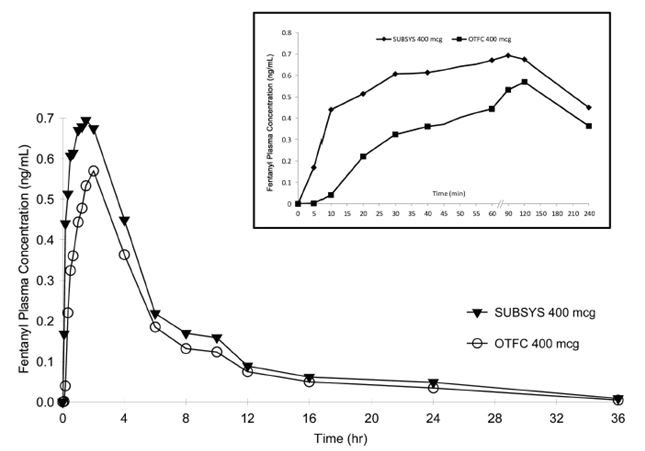
Neither peak fentanyl concentration nor total exposure was appreciably affected by the pretreatment of oral cavity with hot water or refrigerated iced water, low or high pH beverages when SUBSYS was administered under fasted condition.
Dose proportionality among the five available strengths of SUBSYS (100, 200, 400, 600, and 800 mcg) has been evaluated in a crossover study in healthy subjects. Mean plasma fentanyl levels following these five dose levels of SUBSYS are shown in Figure 2. The curves for each dose level are similar in shape with increasing dose levels producing increasing plasma fentanyl levels. The C max and AUC 0-∞ values increased in a dose-dependent manner that is approximately proportional to the SUBSYS doses administered.
Figure 2. Mean Fentanyl Plasma Concentration-Time Profiles (36 hours) after Administration of SUBSYS 100 mcg, 200 mcg, 400 mcg, 600 mcg, and 800 mcg in Healthy Subjects
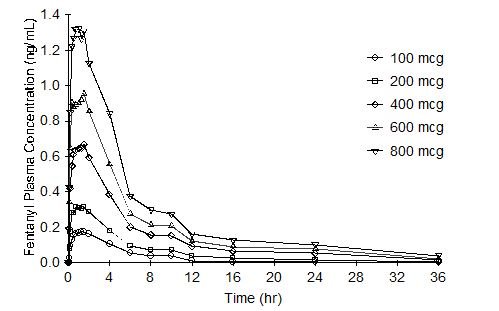
The pharmacokinetic parameters of the five strengths of SUBSYS tested are shown in Table 8. The mean Cmax ranged from 0.202 – 1.610 ng/mL. The median time of maximum plasma concentration (T max) across these five doses of SUBSYS varied from 0.67 - 1.25 hours (range of 0.08 – 4.00 hours) as measured after the start of administration.
| Pharmacokinetic Parameter (Mean (%CV)) | 100 mcg | 200 mcg | 400 mcg | 600 mcg | 800 mcg |
|---|---|---|---|---|---|
|
* Data for T max presented as median (range) |
|||||
| T max (hr)* | 1.25
(0.17-2.05) | 1.25
(0.17-2.03) | 1.00
(0.17-2.03) | 0.67
(0.08-2.00) | 0.69
(0.17-4.00) |
| C max (ng/mL) | 0.202
(28.35) | 0.378
(29.69) | 0.800
(27.66) | 1.17
(32.48) | 1.610
(37.22) |
| AUC last (ng/mL × hr) | 0.9776
(49.82) | 1.985
(40.93) | 4.643
(44.53) | 6.682
(32.46) | 9.450
(36.62) |
| AUC 0-∞ (ng/mL × hr) | 1.245
(53.82) | 2.475
(46.48) | 5.342
(44.16) | 7.446
(81.54) | 10.38
(35.60) |
| T ½ (hr) | 5.25
(89.92) | 8.45
(77.94) | 11.03
(62.20) | 10.64
(41.73) | 11.99
(32.15) |
Distribution
Fentanyl is highly lipophilic. Animal data showed that following absorption, fentanyl is rapidly distributed to the brain, heart, lungs, kidneys and spleen followed by a slower redistribution to muscles and fat. The plasma protein binding of fentanyl is 80-85%. The main binding protein is alpha-1-acid glycoprotein, but both albumin and lipoproteins contribute to some extent. The free fraction of fentanyl increases with acidosis. The mean volume of distribution at steady state (Vss) was 4 L/kg.
Elimination
Metabolism
Fentanyl is metabolized in the liver and in the intestinal mucosa to norfentanyl by cytochrome P450 3A4 isoform. Norfentanyl was not found to be pharmacologically active in animal studies
[see Drug Interactions (7)] .
Excretion
Fentanyl is primarily (more than 90%) eliminated by biotransformation to N-dealkylated and hydroxylated inactive metabolites. Less than 7% of the dose is excreted unchanged in the urine, and only about 1% is excreted unchanged in the feces. The metabolites are mainly excreted in the urine, while fecal excretion is less important. The total plasma clearance of fentanyl was 0.5 L/hr/kg (range 0.3 - 0.7 L/hr/kg). The terminal half-life after SUBSYS administration is from 5 to 12 hours.
Specific Population
Patients with mucositis:
The effect of mucositis (Grades 1 and 2) on the pharmacokinetics of SUBSYS was studied in a group of cancer patients with mucositis (N = 7 for Grade 1 and N = 2 for Grade 2) and without mucositis (N = 8). A single 100 mcg dose was administered. Mean summary statistics (standard deviation in parentheses) for patients with Grade 1 mucositis and patients without mucositis are presented in Table 9. Cancer patients with Grade 1 mucositis exhibited 73% greater Cmax and 52% greater AUClast values in comparison to patients without mucositis. The two cancer patients with Grade 2 mucositis had 4- and 7-fold higher C max and ≥3- fold higher AUC last values compared to patients without mucositis.
Monitor patients with Grade 1 mucositis closely for signs of respiratory and central nervous system depression particularly during initiation of therapy with SUBSYS. As a result of the large and variable increase in exposure of fentanyl, use of SUBSYS should be avoided in patients with Grade 2 and more severe mucositis unless the benefits are expected to outweigh the risk of respiratory depression.
| Patient Status | N | C max (ng/mL) | T max (hr)* | AUC 0-last (ng/mL × hr) |
| Mucositis Grade 1 | 7 | 0.45 (95.56) | 0.25 (0.25, 2.00) | 1.38 (44.93) |
| No Mucositis | 8 | 0.26 (57.69) | 0.38 (0.25, 2.00) | 0.91 (14.29) |
| * Data for T max presented as median (range) | ||||
13. Nonclinical Toxicology
13.1 Carcinogenesis, Mutagenesis, Impairment of Fertility
Carcinogenesis
Long-term studies in animals to evaluate the carcinogenic potential of fentanyl have not been conducted
Mutagenesis
Fentanyl citrate was not mutagenic in the
in vitro Ames reverse mutation assay in
S. typhimurium or E. coli or the mouse lymphoma mutagenesis assay, and was not clastogenic in the in vivo mouse micronucleus assay.
Impairment of Fertility
Fentanyl has been shown to impair fertility in rats at doses of 30 mcg/kg intravenously and 160 mcg/kg subcutaneously. Conversion to the human equivalent doses indicates that this is within the range of the human recommended dosing for SUBSYS.
14. Clinical Studies
The efficacy of SUBSYS was demonstrated in a double-blind, placebo-controlled, crossover study in opioid tolerant adult patients with cancer and breakthrough pain. The dose range studied was from 100 mcg per dose to 1600 mcg per dose. Patients entering the trial must have had on average 1-4 episodes of pain per day not controlled on stable, chronic maintenance doses of opioid medication of at least 60 mg/day of morphine, 25 mcg/hr of transdermal fentanyl, or an equianalgesic dose of another opioid for at least 7 days.
The study began with an open-label dose titration period followed by a double-blind treatment period. The goal of titration was to find the dose of SUBSYS that provided adequate analgesia with acceptable side effects. Patients were titrated from a 100 mcg starting dose. Once a successful dose was established, patients were enrolled into the double-blind period and randomized to a sequence of 10 treatments; 7 with SUBSYS and 3 with placebo.
Patients assessed pain intensity on a 100 mm visual analog scale that rated the pain as 0=none to 100=worst possible pain. With each episode of breakthrough pain, pain intensity was assessed first and then treatment was administered. Pain intensity (0-100) was then measured at 5, 10, 15, 30, 45 and 60 minutes after the start of administration. The summed pain intensity difference from baseline to 30 minutes after dosing was the primary efficacy measure.
Out of 130 patients who entered the titration phase, 98 (75%) were able to titrate to a dose that adequately reduced pain with tolerable side effects and entered into the double-blind period.
The breakdown of successful dose for the patients entering the double-blind period of the study is as follows:
| SUBSYS Dose | Total No. (%)
n=96 |
| 100 mcg | 4 (4%) |
| 200 mcg | 7 (7%) |
| 400 mcg | 14 (15%) |
| 600 mcg | 15 (16%) |
| 800 mcg | 23 (24%) |
| 1200 mcg (2 × 600 mcg) | 20 (21%) |
| 1600 mcg (2 × 800 mcg) | 13 (14%) |
SUBSYS produced a statistically significantly greater reduction in pain intensity compared to placebo as measured by the Summed Pain Intensity Differences scale (SPID) at 30 minutes.
The primary outcome measure, the mean sum of the pain intensity difference at 30 minutes (SPID30), was statistically significantly higher for SUBSYS than for placebo. The difference in mean pain intensity based on a 100 mm visual analog scale is displayed in Figure 3.
Figure 3. Pain Intensity Differences over Time
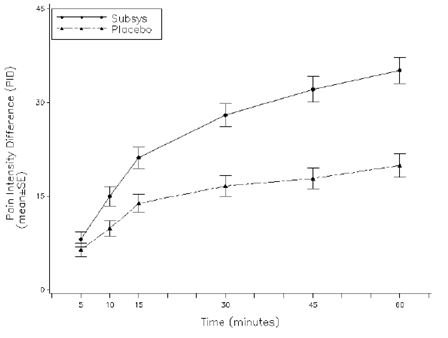
16. How is Subsys supplied
SUBSYS (fentanyl sublingual spray) is supplied as spray units.
Each SUBSYS carton contains individual blister packages containing spray units of SUBSYS, a supply of small white disposal bags for disposing of used SUBSYS units and charcoal-lined disposal pouches, a supply of charcoal-lined disposal pouches (wrapped in aluminum foil) for use when disposing of the contents of unused SUBSYS units, a Medication Guide and a Package Insert.
SUBSYS is supplied in individually sealed, protective blister packages. These blister packages are packed into 10 and 30 per shelf cartons.
Each unit dose system consists of a white actuator attached to a light purple vial holder. The dosage strength is marked on the label on the actuator, the blister package and the shelf carton. See the protective blister package and shelf carton for product information.
| Dosage Strength (fentanyl base) | Carton/Blister Package Color | NDC Number | |
| 100 mcg | Blue | 71500-001-10 | |
| 200 mcg | Green | 71500-002-30 | |
| 400 mcg | Magenta (Pink) | 71500-004-30 | |
| 600 mcg | Purple | 71500-006-30 | |
| 800 mcg | Orange | 71500-008-30 | |
| 1200 mcg | Brown | 71500-012-15 | |
| 1600 mcg | Red | 71500-016-15 | |
Note: Colors are a secondary aid in product identification. Please be sure to confirm the printed dosage before dispensing.
Storage and Handling
Store at 20-25ºC (68-77ºF) with excursions permitted between 15º and 30ºC (59º to 86ºF) until ready to use. [See USP Controlled Room Temperature.] Do not use if the blister package has been opened.
Store SUBSYS securely and dispose of properly [see Patient Counseling Information (17)].
17. Patient Counseling Information
Advise the patient to read the FDA-approved patient labeling ( Medication Guide).
Storage and Disposal of Unused and Used SUBSYS [see Instructions for Use].
Because of risk associated with accidental ingestion, misuse, and abuse, advise patients to store SUBSYS securely, out of sight and reach of children and in a location not accessible by others, including visitors to the home [see Warnings and Precautions (5.1, 5.2), Drug Abuse and Dependence (9.2)]. Inform Patients that leaving SUBSYS unsecured can pose a deadly risk to others in the home.
Advise patients and caregivers that when medicines are no longer needed, they should be disposed of promptly.
Disposal of Unopened SUBSYS Unit Dose Systems When No Longer Needed
Patients and members of their household must be advised to dispose of any unopened units remaining from a prescription as soon as they are no longer needed.
To dispose of the unopened SUBSYS units:
1. Using a pair of scissors, cut the blister package on the line marked by an image of a pair of scissors and the instruction “cut to open” printed on the blister. Peel back the blister material to remove the SUBSYS unit from the package.
2. Remove a charcoal-lined disposal pouch from the aluminum foil package by tearing open the package at the notch.
3. Hold the charcoal-lined disposal pouch with the opening facing up. Put the nozzle of the SUBSYS spray unit upside-down into the opening of the charcoal-lined disposal pouch.
4. Squeeze your fingers and thumb together to spray SUBSYS into the charcoal-lined disposal pouch.
5. Dispose of the empty spray unit in a disposal bag.
6. Repeat the above steps for each unused SUBSYS spray unit. The charcoal-lined disposal pouch may be used for disposing of the contents of up to 10 spray units. Make sure all unused spray units have been sprayed into a charcoal-lined disposal pouch.
7. To seal a used charcoal-lined disposal pouch, remove the backing from the adhesive strip. Fold the flap down and press to seal the charcoal-lined disposal pouch.
8. Place the sealed charcoal-lined disposal pouch into a disposal bag.
9. To seal the disposal bag, remove the backing from the adhesive strip. Fold the flap down and press to seal.
10. Discard the sealed disposal bag in the trash out of the reach of children.
Disposal of Used SUBSYS Unit Dose Systems
Patients must be instructed to safely dispose of used SUBSYS units.
1. After administration of SUBSYS, place the used spray unit into one of the disposable bags provided with your prescription.
2. Seal the bag and discard into a trash container out of the reach of children.
Detailed instructions for the proper storage, administration, disposal, and important instructions for managing an overdose of SUBSYS are provided in the SUBSYS Medication Guide. Encourage patients to read this information in its entirety and give them an opportunity to have their questions answered.
In the event that a caregiver requires additional assistance in disposing of excess unusable units that remain in the home after a patient has expired, instruct them to call the toll-free number for West Therapeutic Development, LLC., 1-844-452-9263) or seek assistance from their local DEA office.
Life-Threatening Respiratory Depression
Inform patients of the risk of life-threatening respiratory depression, including information that the risk is greatest when starting SUBSYS or when the dosage is increased, and that it can occur even at recommended dosages.
Educate patients and caregivers on how to recognize respiratory depression and emphasize the importance of calling 911 or getting emergency medical help right away in the event of a known or suspected overdose [ see Warnings and Precautions ( 5.1) ].
Patient Access to Naloxone for the Emergency Treatment of Opioid Overdose
Discuss with the patient and caregiver the availability of naloxone for the emergency treatment of opioid overdose, both when initiating and renewing treatment with SUBSYS. Inform patients and caregivers about the various ways to obtain naloxone as permitted by individual state naloxone dispensing and prescribing requirements or guidelines (e.g., by prescription, directly from a pharmacist, or as part of a community-based program) [ see Dosage and Administration ( 2.2), Warnings and Precautions ( 5.1) ].
Educate patients and caregivers on how to recognize the signs and symptoms of an overdose.
Explain to patients and caregivers that naloxone’s effects are temporary, and that they must call 911 or get emergency medical help right away in all cases of known or suspected opioid overdose, even if naloxone is administered [ see Overdosage ( 10) ].
If naloxone is prescribed, also advise patients and caregivers:
- How to treat with naloxone in the event of an opioid overdose
- To tell family and friends about their naloxone and to keep it in a place where family and friends can access it in an emergency
- To read the Patient Information (or other educational material) that will come with their naloxone. Emphasize the importance of doing this before an opioid emergency happens, so the patient and caregiver will know what to do.
Increased Risk of Overdose and Death in Children Due to Accidental Exposure [see Warnings and Precautions ( 5.2)]
- Healthcare providers and dispensing pharmacists must specifically question patients or caregivers about the presence of children in the home (on a full time or visiting basis) and counsel them regarding the dangers to children from inadvertent exposure.
- Inform patients that accidental exposure, especially in children, may result in respiratory depression or death.
- Instruct patients to take steps to store SUBSYS securely and use the Child Safety Kit to store SUBSYS and other medicines out of the reach of children and to dispose of unused SUBYS by emptying all of the medicine into the charcoal-lined disposal pouch, seal the pouch, and dispose in the trash out of reach of children.
- Instruct patients and caregivers to keep both used and unused SUBSYS out of the reach of children.
SUBSYS Child Safety Kit
Provide patients and their caregivers with a SUBSYS Child Safety Kit. The kit consists of a portable carrying case, a lock for the bag and contains a package of cabinet and drawer child safety latches for securing the storage space at home to help patients store SUBSYS and other medicines out of the reach of children. To obtain a supply of Child Safety Kits, health care professionals can call West Therapeutic Development, LLC., at 1-844-452-9263.
Interactions with Benzodiazepines and Other CNS Depressants
Inform patients and caregivers that potentially fatal additive effects may occur if SUBSYS is used with benzodiazepines or other CNS depressants, including alcohol, and not to use these concomitantly unless supervised by a healthcare provider
[see Warnings and Precautions (
5.4), Drug Interactions (
7)].
Addiction, Abuse, and Misuse
Inform patients that the use of SUBSYS, even when taken as recommended, can result in addiction, abuse, and misuse, which can lead to overdose and death
[see Warnings and Precautions (
5.6)].
Instruct patients not to share SUBSYS with others and to take steps to protect SUBSYS from theft or misuse.
Transmucosal Immediate-Release Fentanyl (TIRF) REMS
SUBSYS is available only through a restricted program called the Transmucosal Immediate Release Fentanyl (TIRF) REMS [see Warnings and Precautions (5.7)]. Inform the patient of the following notable requirements:
- Outpatients must be enrolled in the REMS program
- Patients must be opioid-tolerant to receive SUBSYS
- SUBSYS is available only from certified pharmacies participating in this program. Therefore, provide patients with the telephone number and website for information on how to obtain the product.
- Pharmacies, outpatients, and healthcare professionals who prescribe to outpatients are required to enroll in the program. Inpatient pharmacies must develop policies and procedures to verify opioid tolerance in inpatients who require SUBSYS while hospitalized [see Warnings and Precautions ( 5.7)].
Serotonin Syndrome
Inform patients that opioids could cause a rare but potentially life-threatening condition resulting from concomitant administration of serotonergic drugs. Warn patients of the symptoms of serotonin syndrome and to seek medical attention right away if symptoms develop. Instruct patients to inform their physicians if they are taking, or plan to take serotonergic medications.
[see Warnings and Precautions (
5.10), Drug Interactions (
7)]
.
MAOI Interaction
Inform patients to avoid taking SUBSYS while using any drugs that inhibit monoamine oxidase. Patients should not start MAOIs while taking SUBSYS
[see Warnings and Precautions (
5.1,
5.10); Drug Interactions (
7)].
Adrenal Insufficiency
Inform patients that opioids could cause adrenal insufficiency, a potentially life-threatening condition. Adrenal insufficiency may present with non-specific symptoms and signs such as nausea, vomiting, anorexia, fatigue, weakness, dizziness, and low blood pressure. Advise patients to seek medical attention if they experience a constellation of these symptoms
[see Warnings and Precautions (
5.11)]
.
Important Administration Instructions [see Dosage and Administration ( 2)]
- Instruct patients not to take SUBSYS for acute pain, postoperative pain, pain from injuries, headache, migraine or any other short-term pain, even if they have taken other opioid analgesics for these conditions.
- Instruct patients on the meaning of opioid tolerance and that SUBSYS is only to be used as a supplemental pain medication for patients with pain requiring around-the-clock opioids, who have developed tolerance to the opioid medication, and who need additional opioid treatment of breakthrough pain episodes.
- Instruct patients that, if they are not taking an opioid medication on a scheduled basis (around-the-clock), they should not take SUBSYS.
- Instruct patients that, if the breakthrough pain episode is not relieved 30 minutes after administration, they may take only one additional dose of SUBSYS using the same strength for that episode. Thus, patients should take no more than two doses of SUBSYS for any breakthrough pain episode.
- Instruct patients that they MUST wait at least 4 hours before treating another episode of breakthrough pain with SUBSYS.
- Instruct patients NOT to share SUBSYS and that sharing SUBSYS with anyone else could result in the other individual’s death due to overdose.
- Make patients aware that SUBSYS contains fentanyl which is a strong pain medication similar to hydromorphone, methadone, morphine, oxycodone, and oxymorphone.
- Instruct patients to talk to their doctor if breakthrough pain is not alleviated or worsens after taking SUBSYS.
- Instruct patients to use SUBSYS exactly as prescribed by their doctor and not to take SUBSYS more often than prescribed.
- Provide patients and their caregivers with a Medication Guide each time SUBSYS is dispensed because new information may be available.
Hypotension
Inform patients that SUBSYS may cause orthostatic hypotension and syncope. Instruct patients how to recognize symptoms of low blood pressure and how to reduce the risk of serious consequences should hypotension occur (e.g., sit or lie down, carefully rise from a sitting or lying position)
[see Warnings and Precautions (
5.12)]
.
Anaphylaxis
Inform patients that anaphylaxis have been reported with ingredients contained in SUBSYS. Advise patients how to recognize such a reaction and when to seek medical attention
[see Contraindications (
4), Adverse Reactions (
6)].
Pregnancy
Neonatal Opioid Withdrawal Syndrome
Inform patients that prolonged use of SUBSYS during pregnancy can result in neonatal opioid withdrawal syndrome, which may be life-threatening if not recognized and treated
[See Warnings and Precautions (
5.8), Use in Specific Populations (
8.1)]
.
Embryo-Fetal Toxicity
Inform female patients of reproductive potential that SUBSYS can (or may) cause fetal harm and to inform the healthcare provider of a known or suspected pregnancy
[see Use in Specific Populations (
8.1), Non-Clinical Toxicology (
13.1)].
Lactation
Advise nursing mothers to monitor infants for increased sleepiness (more than usual), breathing difficulties, or limpness. Instruct nursing mothers to seek immediate medical care if they notice these signs
[see Use in Specific Populations (
8.2)]
.
Infertility
Inform patients that chronic use of opioids may cause reduced fertility. It is not known whether these effects on fertility are reversible
[see Adverse Reactions (
6.2), Use in Specific Populations (
8.3)].
Driving or Operating Heavy Machinery
Inform patients that SUBSYS may impair the ability to perform potentially hazardous activities such as driving a car or operating heavy machinery. Advise patients not to perform such tasks until they know how they will react to the medication
[see Warnings and Precautions (
5.16)]
.
Constipation
Advise patients of the potential for severe constipation, including management instructions, and when to seek medical attention
[see Adverse Reactions (
6), Clinical Pharmacology (
12.2)]
.
Manufactured by:
Renaissance Lakewood, LLC, Lakewood, NJ 08701
Manufactured for and Distributed by:
West Therapeutic Development, LLC., Northbrook, IL 60062
U.S. Patents: 8,486,972 B2 and 8,486,973 B2
2104221
April 2021
SUBSYS ® is a registered trademark of West Therapeutic Development, LLC
|
This Medication Guide has been approved by the U.S. Food and Drug Administration. |
Issued: 03/2021 |
| Medication Guide
SUBSYS ® (sub sis)) (fentanyl) sublingual spray , CII |
|
| Important information about SUBSYS:
Do not use SUBSYS unless you are regularly using another opioid pain medicine around-the-clock for at least one week or longer for your cancer pain and your body is used to these medicines (this means that you are opioid tolerant). You can ask your healthcare provider if you are opioid tolerant. Keep SUBSYS in a safe place away from children. Get emergency help right away if:
|
|
SUBSYS is:
Important information about SUBSYS:
|
|
Do not take SUBSYS if:
|
|
Before taking SUBSYS, tell your healthcare provider if you have a history of:
|
|
When taking SUBSYS:
|
|
|
|
The possible side effects of SUBSYS:
These are not all the possible side effects of SUBSYS. Call your doctor for medical advice about side effects. You may report side effects to FDA at 1-800-FDA-1088. For more information go to dailymed.nlm.nih.gov. Manufactured by: Renaissance Lakewood, LLC, Lakewood, NJ 08701 Distributed by: West Therapeutic Development, LLC, Northbrook, IL, 60062, (1-844-452-9263) |
|
Child Safety Kit
The SUBSYS Child Safety Kit contains important information on the storage and handling of SUBSYS.
The SUBSYS Child Safety Kit includes:
- a
portable pouch (FIGURE A) and lock (FIGURE B) for you to keep a small supply of SUBSYS. Keep the rest of your SUBSYS in the locked storage space.
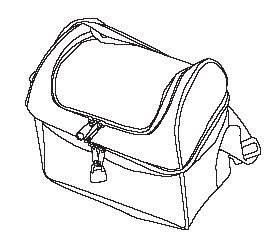
Figure A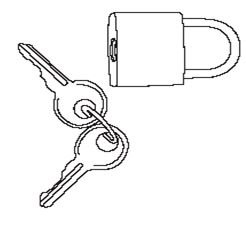
Figure B - a
package of cabinet and drawer child safety latches (FIGURE C) to secure the storage space where SUBSYS is kept at home.

Figure C - Keep the pouch locked and away from children. (See FIGURE C)
Instructions for Use
Before you use SUBSYS, it is important that you read the Medication Guide and these Instructions for Use. Be sure that you read, understand, and follow these Instructions for Use so that you use SUBSYS the right way. Ask your healthcare provider or pharmacist if you have questions about the right way to use SUBSYS.
What will I find in the SUBSYS package?
Each SUBSYS Carton contains
(See
Figure D)
:
- individual blister packages containing spray units of SUBSYS
- a supply of small white disposal bags for use when disposing of used SUBSYS units and charcoal-lined disposal pouches
- a supply of charcoal-lined disposal pouches (wrapped in aluminum foil) for use when disposing of the contents of unused SUBSYS units
- Call West Therapeutic Development, LLC at 1-844-452-9263 for additional supplies of disposal bags and charcoal-lined disposal pouches.
- a Medication Guide (not shown)
- a Package Insert (not shown)
-
When you get an episode of breakthrough cancer pain, take the dose prescribed by your healthcare provider as follows: SUBSYS comes in individual blister packages. Do not open the blister package until you are ready to use it.
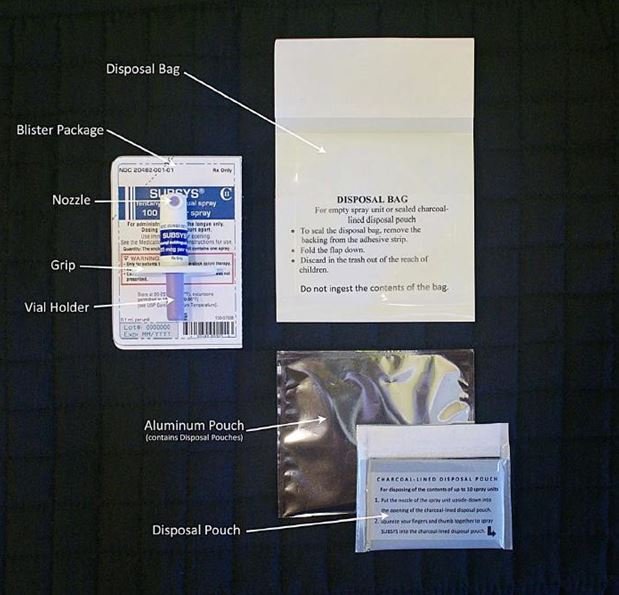
Figure D - Remove the SUBSYS spray unit from the blister package by cutting the dashed line with a pair of scissors.
(See
Figure E.)
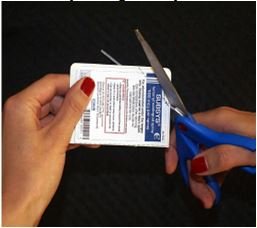
Figure E - To correctly use SUBSYS:
- Swallow any saliva in your mouth
- Hold the SUBSYS spray unit
upright using your index and middle fingers and thumb.
(See
Figure F.)
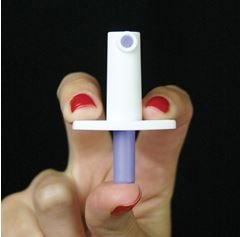
Figure F - Point the nozzle
into your mouth and
under your tongue.
(See
Figures G and
H)
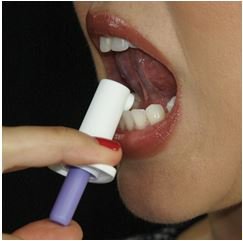
Figure G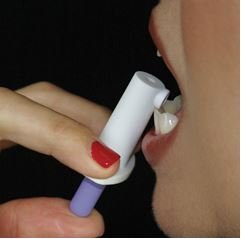
Figure H - Squeeze your fingers and thumb together to spray SUBSYS under your tongue. (See Figure I)
- Hold the medicine under your tongue for
30-60 seconds. Do not spit out any medicine. Do not rinse your mouth.
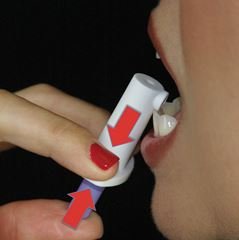
Figure I - The SUBSYS spray unit will remain locked after use.
(See
Figure J)
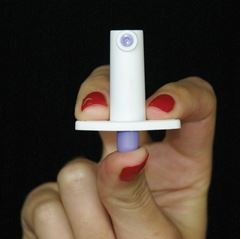
Figure J
Disposing of SUBSYS:
After using SUBSYS, dispose of the spray unit as follows:
- Place the used SUBSYS spray unit into one of the disposal bags provided in the carton containing the spray units.
(See
Figure K)
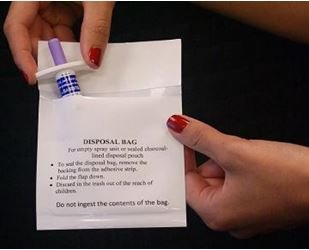
Figure K - Remove the backing from the adhesive strip.
- Fold the flap to seal the bag.
(See
Figure L)
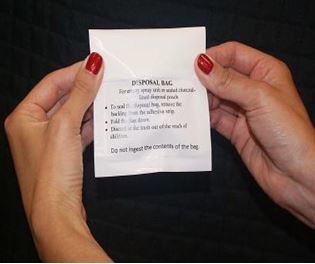
Figure L - Discard in the trash out of the reach of children.
(See
Figure M)
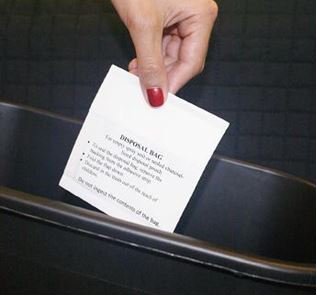
Figure M
Do not ingest the contents of the bag.
Disposal of any unused SUBSYS when no longer needed:
Before you throw away the SUBSYS spray units, you must empty all of the medicine into the charcoal-lined disposal pouch. This protects others, especially children from harm . Charcoal-lined disposal pouches are supplied wrapped in an aluminum foil package.
- Remove a charcoal-lined disposal pouch from the aluminum foil package by tearing open the package at the notch.
(See
Figures N)
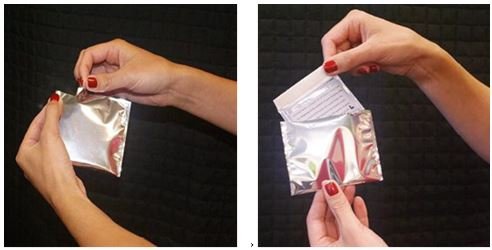
Figure N
- Remove the SUBSYS spray unit from the blister package by cutting the dashed line with a pair of scissors.
(See
Figure O)
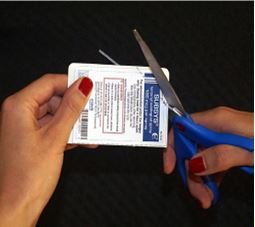
Figure O
- Hold the charcoal-lined disposal pouch with the opening facing up. Put the nozzle of the SUBSYS spray unit upside-down into the opening of the charcoal-lined disposal pouch.
(See
Figure P)
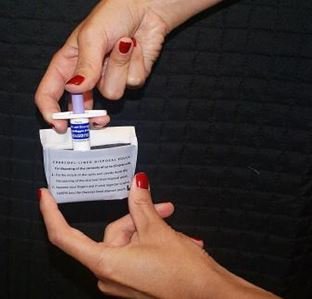
Figure P
- Squeeze your fingers and thumb together to spray SUBSYS into the charcoal-lined disposal pouch.
- Dispose of the spray unit in a disposal bag. (See Figures K and L)
- Repeat steps O and P for each unused SUBSYS spray unit. The charcoal-lined disposal pouch may be used for disposing of the contents of up to 10 spray units.
- Make sure all unused spray units have been sprayed into a charcoal-lined disposal pouch.
To seal a used charcoal-lined disposal pouch, remove the backing from the adhesive strip. (See Figure Q) Fold the flap down and press to seal the charcoal-lined disposal pouch.
Figure Q
- Place the sealed charcoal-lined disposal pouch into a disposal bag.
(See
Figure R)

Figure R
- To seal the disposal bag, remove the backing from the adhesive strip. Fold the flap down and press to seal.
- Discard the sealed disposal bag in the trash out of the reach of children.
(See
Figure S)

Figure S
- Do not ingest the contents of the bag.
If you need help with disposal of SUBSYS, call Insys Therapeutics, Inc. at 1-877-978-2797 or call your local Drug Enforcement Agency (DEA) office.
This Medication Guide has been approved by the U.S. Food and Drug Administration.
Manufactured by:
Renaissance Lakewood, LLC, Lakewood, NJ 08701
for:
West Therapeutic Development, LLC, Northbrook, IL 60062
2007232
Revised March 2021
| SUBSYS
fentanyl spray |
|||||||||||||||||||||||||
|
|||||||||||||||||||||||||
|
|||||||||||||||||||||||||
|
|||||||||||||||||||||||||
|
|||||||||||||||||||||||||
| SUBSYS
fentanyl spray |
|||||||||||||||||||||||||
|
|||||||||||||||||||||||||
|
|||||||||||||||||||||||||
|
|||||||||||||||||||||||||
|
|||||||||||||||||||||||||
| SUBSYS
fentanyl spray |
|||||||||||||||||||||||||
|
|||||||||||||||||||||||||
|
|||||||||||||||||||||||||
|
|||||||||||||||||||||||||
|
|||||||||||||||||||||||||
| SUBSYS
fentanyl spray |
|||||||||||||||||||||||||
|
|||||||||||||||||||||||||
|
|||||||||||||||||||||||||
|
|||||||||||||||||||||||||
|
|||||||||||||||||||||||||
| SUBSYS
fentanyl spray |
|||||||||||||||||||||||||
|
|||||||||||||||||||||||||
|
|||||||||||||||||||||||||
|
|||||||||||||||||||||||||
|
|||||||||||||||||||||||||
| SUBSYS
fentanyl spray |
|||||||||||||||||||||||||
|
|||||||||||||||||||||||||
|
|||||||||||||||||||||||||
|
|||||||||||||||||||||||||
|
|||||||||||||||||||||||||
| SUBSYS
fentanyl spray |
|||||||||||||||||||||||||
|
|||||||||||||||||||||||||
|
|||||||||||||||||||||||||
|
|||||||||||||||||||||||||
|
|||||||||||||||||||||||||
| Labeler - West Therapeutics Development, LLC (080707245) |
Frequently asked questions
- Which drugs cause opioid-induced constipation?
- What drugs cause pinpoint pupils?
- How long does Fentanyl stay in your system?
- Carfentanil vs Fentanyl: Which is more dangerous?
- Why is fentanyl so dangerous?
- Fentanyl test strips: where to get & how to use?
- What are the symptoms of a fentanyl overdose?
- Which painkiller should you use?
- How does fentanyl compare to heroin or other opiates?
More about Subsys (fentanyl)
- Check interactions
- Compare alternatives
- Reviews (12)
- Latest FDA alerts (15)
- Side effects
- Dosage information
- During pregnancy
- FDA approval history
- Drug class: Opioids (narcotic analgesics)
- Breastfeeding
- En español
Patient resources
Professional resources
Other brands
Duragesic, Sublimaze, Fentora, Actiq, ... +2 more

